Seller Score
As the most important indicator to measure the health of the shop, sellers need to know the scoring standard of the seller score and how to improve it.
1. Seller Center Seller Score
1.1 What Is Seller Score?
On the Jumia platform, the seller score refers to the comprehensive operation performance of the shop, including cancellation rate (CR), quality return rate (QRR), and item score of the shop in the past period. The higher the score, the higher the consumer's trust to the shop.
Good seller scores are mainly used in the following three aspects:
- Helping consumers find reliable shops;
- Helping sellers monitor the health of shops, discover problems, and optimize shops in time;
- Attracting more consumers and increasing sales.
1.2 How to Check My Seller Score?
Sellers can log in to the main page of the Seller Center and check "YOUR RATING" to view the seller score.
Through the item page, consumers can check the "SELLER INFORMATION" on the right to view the seller score. In the following item pages, the seller score in the Seller Center is assumed to be 2.7 and then divided by the total score (5). The final score displayed is 54% Seller Score (2.7/5=54%), that is, the percentage of the seller's score to the total score is 54%:
1.3 Composition of Seller Score and Scoring Standards
The seller score consists of the following three indicators, which are updated every Tuesday:
| No. | Key performance | Performance definition |
|---|---|---|
| 1 | Cancellation Rate (due to sellers' reason, CR for short) | 体现了店铺库存的稳定程度,指过去4周内作为缺货(Out of stock)被取消的产品数量百分比 |
| 2 | Quality Return Rate (due to sellers' reason, QRR for short) | 体现了店铺产品的质量水平,指过去4周内经过售后团队核实的有质量问题的产品数量百分比 |
| 3 | Average Customer Rating (ACR) | 体现了消费者对使用过的产品或服务的评价,指过去4周内店铺有收到的所有产品评分的平均值 |
Note: "The past 4 weeks" is based on the current week when the seller scores of shops are updated. "Minus 2 weeks to minus 5 weeks" composes a complete calculation period. For example, the seller score shown in the background in the 50th week is the average of the scores rated in the 48th, 47th, 46th, and 45th weeks.
- Only those orders canceled by the seller due to OOS or automatically canceled by the system because the packages are not sent to the warehouse for scanning within the prescribed time limit (5 workdays) are not calculated. The orders that are canceled due to other reasons (canceled by customers, platform system problems, etc.) are not included in the calculation scope.
- A detailed explanation of Out of Stock: Once the order is generated, the seller has 5 workdays for goods preparing, printing shipping labels, warehouse scanning, and other operations. Otherwise, the system cancels the order because the item is out of stock.
- The default seller score is 3.0 within 30 days after the shop is activated. If there are 5 or more finished orders within 30 days, the seller score will be adjusted according to the shop's performance.
Note:
- CR is calculated based on the number of canceled items, not the canceled orders. Besides, CR is calculated according to the date of order generation, and the date corresponds to the calculation period of the Seller Score.
- QRR is calculated based on the number of returned items, not the returned orders. Besides, QRR is calculated according to the date of the order delivered, and the date corresponds to the calculation period of Seller Score.
Calculation examples are as follows:
Calculation example of the 50th week's CR
(The 50th week's CR of the shop is calculated based on the orders generated within the previous four weeks, i.e. 48th, 47th, 46th, and 45th weeks)
| Site | Shop name | Orders (Week 45 - 48 | Total SKUs (Week 45 - 48) | SKUs canceled (Week 45 - 48) | 50th week's CR (Canceled SKUs/Total SKUs) |
|---|---|---|---|---|---|
| NG | Jumia | 2 | 110 (Order A includes 100 SKUs,Order B includes 10 SKUs) | 100 SKUs of Order A were canceled by the system due to delayed delivery | 100/110=91% |
Calculation example of the 50th week's QRR
(The 50th week's RR of the shop is calculated based on the orders delivered within the previous four weeks, i.e. 48th, 47th, 46th, and 45th weeks)
| Site | Shop name | Orders (Week 45 - 48) | Total SKUs (Week 45 - 48) | SKUs returned (Week 45 - 48) | 50th week's QRR (returned SKUs/Total SKUs) |
|---|---|---|---|---|---|
| NG | Jumia | 2 | 60(Order A includes 10 SKUs delivered,Order B includes 50 SKUs delivered) | 10 SKUs of Order A were returned due to poor quality | 10/60=17% |
Scoring standard and weight of seller score:
*Weight:
| Factors for seller score rating | Ratio |
|---|---|
| Cancellation Rate (cancellation rate due to sellers' reason, CR) | 1/3 |
| Quality Return Rate (return rate due to sellers' reason, QRR) | 1/3 |
| Average Customer Rating (average rating of users,ACR) | 1/3 |
*Scoring standard:
| Score | Range | CR | QRR | ACR (f) |
|---|---|---|---|---|
| 5 | Excellent | 0%-0.1% | 0%-0.1% | 4.5≤f≤5 |
| 4 | Good | 0.1%-1% | 0.1%-1% | 4≤f<4.5 |
| 3 | Average | 1%-2% | 1%-2% | 3≤f<4 |
| 2 | Bad | 2%-3% | 2%-3% | 2≤f<3 |
| 1 | Very bad | 3%-4% | 3%-4% | 1.5≤f<2 |
| 0 | Very bad | 4%-100% | 4%-100% | f<1.5 |
Example
It is assumed that CR, QRR, and ACR of Seller A are as follows:
First, match the corresponding range; then, get the score according to the range; finally, multiply each score by the weight (1/3) and sum them up to get the score.
| Item | Performance | Range | Score |
|---|---|---|---|
| Cancellation Rate (CR) | 2.50% | Bad | 2 |
| Quality Return Rate (QRR) | 3.50% | Very bad | 1 |
| Average Customer Rating (ACR) | 3.5 | Average | 3 |
| The proportion of each item is 1/3, and the final score of the shop is: 2*1/3+1*1/3+3*1/3=2 |
1.4 How Does Seller Score Impact Shops?
- Your seller score will be displayed on the item page. Generally, the item conversion rate of the shops with a high seller score is about 5 to 10 times greater than that of non-high-scoring shops.
- The platform gives more data support to the shops with a high seller score. The higher the score, the more data given.
- For shops with low seller scores (<3 only), in addition to data limitation, the platform will also charge additional commissions at different gradients based on their scores.
The additional commission* is charged as follows (taking Nigeria as an example):
Contribution for low seller score = Commission fee for last week * ratio for low seller score
Example of a seller with 5% commission on Jumia
| Seller Score Min | Seller Score Max | Contribution% | Weekly Sales (Last week) | Commission - Last week (NGN) | Contribution Fee - this week (NGN) |
|---|---|---|---|---|---|
| 3 | 5 | 0% | 35,000 NGN | 5%* 35,000 = 1,750 | 0% x 1,750 = 0 |
| 2.5 | 3 | 20% | 35,000 NGN | 5%* 35,000 = 1,750 | 20% x 1,750 = 350 |
| 2 | 2.5 | 30% | 35,000 NGN | 5%* 35,000 = 1,750 | 30% x 1,750 = 525 |
| 1.5 | 2 | 50% | 35,000 NGN | 5%* 35,000 = 1,750 | 50% x 1,750 = 875 |
| 0 | 1.5 | 75% | 35,000 NGN | 5%* 35,000 = 1,750 | 75% x 1,750 = 1,312.5 |
The extra commission is shown in the bill as "Contribution for low seller score:
- High CR, high QRR and low ACR lead to the following results:
- Triggering shop delisting (Click here to see how to apply for shop relisting; click here to view relevant policies)
- items are rejected for themed promotion (only quality items are allowed).
- Decreased exposure rate (the seller score and related indicators are visible to buyers, which affects consumers' trust in goods).
1.5 How to Improve the Seller Score?
The seller score is composed of CR, QRR, and ACR. To keep a high seller score, the shop owner shall ensure that each indicator has good performance.
How to avoid CR (cancellation rate due to seller's reason)?
- Short-term solutions
- Increasing order exposure: reduce the impact of OOS by increasing sales volume through discounts, advertising, promotion, etc.
- Avoiding new OOS orders: timely adjust the inventory, and delist the items with 0 inventory.
- A large number of orders are going to expire and not handled: the situation should be timely fed back to the platform through RAC for support.
- Long-term solutions
Well inventory management: keep supply stable/timely update inventory/stock up before major promotion.
- Well delivery management: timely check new orders every day; check the item quality before delivery; reduce the wrong and miss delivery, and avoid QC failure
- Well logistics management: timely track the arrival and scanning of packages; select superior third-party logistics company to avoid missing packages or delayed delivery
- Summary of FAQ
Promptly check new order notifications in the mailbox to timely deal with orders.
- Update the order status to "Ready to ship" before printing the shipping label.
- Select the correct shipping provider before printing the shipping label. Once the wrong one is selected and printed, the order number will be tracked and cannot be revoked, and the order cannot be scanned.
- Get familiar with the delivery process of Dropshipping (DS) packages, including overweight, oversiz,e and split delivery, etc.
- Be clear about SEKO warehouse and postal parcel warehouse to prevent shipping to the wrong warehouse and affecting the receiving time.
- Be familiar with Smart QC rules to avoid order cancellation by the system due to QC failure.
- When encountering abnormal orders, ask for help through RAC in time (e.g. you cannot click "Ready to ship", and you have deleted SKU order, etc.).
How to reduce QRR (return rate due to sellers' reasons)?
- Preventive measures
Make sure the correct items (color, size, etc.) are shipped.
- Ensure that the original items are delivered (e.g.: non-counterfeit).
- Correctly pack the items as per the packing guidance of the platform.
- Describe the item function, content, etc. in detail on the item page to ensure that customers receive the item that matches the description on the website.
- Post-return optimization
Sellers can find "Return" related orders through the following path, and click on orders to view the reasons for the return.
- "Status" shows the return reason; "Comments" gives specific explanations or figures
*The following table lists the rank of common reasons for Quality Return. Sellers should focus on the orders with the following return reasons, *and optimize items according to the descriptions of customers or pictures provided by the after-sales team to reduce returns.
| Return Reason | RANK |
|---|---|
| CR06 - Item stopped working well after usage | Top 1 |
| CR12 - Item received broken or defective | Top 2 |
| CR24 - Wrong item / color / size / model | Top 3 |
| CR15 - Item received with missing parts or accessories | Top 4 |
| CR13 - Packaging was damaged | Top 5 |
How to improve ACR (Average Customer Rating)?
Because CR and QRR affect customer experience to various degrees, it is necessary to retain CR and QRR at a low level to reduce negative comments.
Furthermore:
- Do not over-render pictures, so as to prevent the customers from giving negative comments due to color differences and other problems.
- Items should have (simple) operation instructions, so as to avoid customers giving negative comments because they do not know how to use the items.
- The material of the item should match its description on the website, so as to prevent customers from making negative comments because the items received are different from the description on the website.
- The size of fashion items should correspond to the local standard (e.g. Nigeria: UK Size), so as to prevent customers from making negative comments because they don't know how to use them.
- Voltage, plug, and other accessories of an electronic item should comply with the local standard (e.g. Nigeria: UK Size), so as to prevent customers from making negative comments because they cannot use them.
2.Vendor Center Seller Score
2.1 What is Seller Score ?
On the Jumia platform, the seller score refers to the comprehensive operation performance of the shop, including cancellation rate (CR), quality return rate (QRR), and item score of the shop in the past period. The higher the score, the higher the consumer's trust in the shop.
Good seller scores are mainly used in the following three aspects:
- Helping consumers find reliable shops;
- Helping sellers monitor the health of shops, discover problems, and optimize shops in time;
- Attracting more consumers and increasing sales.
2.2 How to Check My Seller Score?
Sellers can log in to the main page of the Seller Center and check "YOUR RATING" to view the seller score.
Click the "Country" drop-down box on the right hand side to filter the corresponding country.
Through the item page, consumers can check the "SELLER INFORMATION" on the right to view the seller score. In the following item pages, the seller score in the Seller Center is assumed to be 2.7 and then divided by the total score (5). The final score displayed is 54% Seller Score (2.7/5=54%), that is, the percentage of the seller's score to the total score is 54%:
2.3 Composition of Seller Score and Scoring Standards
The seller score consists of the following three indicators, which are updated every Tuesday:
| 序 | 关键指标 | Performance definition |
|---|---|---|
| 1 | Cancellation Rate (卖家原因产生的取消率,简称CR) | stability of store inventory, refers to the % of products that canceled as Out of stock in the past 4 weeks |
| 2 | Quality Return Rate (卖家原因产生的退货率,简称QRR) | quality level of the products,% of products with quality problems verified by the after-sales team in the past 4 weeks |
| 3 | Average Customer Rating (用户平均评分,简称ACR) | consumer's evaluation of the used product or service, refers to the average of all product ratings received by the store in the past 4 weeks |
- A detailed explanation of Out of Stock: Once the order is generated, the seller has 5 workdays for goods preparation, printing shipping labels, warehouse scanning, and other operations. Otherwise, the system cancels the order because the item is out of stock.
- Only those orders canceled by the seller due to OOS or automatically canceled by the system because the packages are not sent to the warehouse for scanning within the prescribed time limit (5 workdays) are calculated. The orders that are canceled due to other reasons (canceled by customers, platform system problems, etc.) are not included in the calculation scope.
- The default seller score is 3.0 within 30 days after the shop is activated. If there are 5 or more finished orders within 30 days, the seller score will be adjusted according to the shop's performance.
Note:
- CR is calculated based on the number of canceled items, not the canceled orders. Besides, CR is calculated according to the date of order generation, and the date corresponds to the calculation period of the Seller Score.
- QRR is calculated based on the number of returned items, not the returned orders. Besides, QRR is calculated according to the date of the order delivered, and the date corresponds to the calculation period of Seller Score.
- Calculation example of the 50th week's CR
(The 50th week's CR of the shop is calculated based on the orders generated within the previous four weeks, i.e. 48th, 47th, 46th, and 45th weeks)
| Site | Shop name | Orders (Week 45 - 48 | Total SKUs (Week 45 - 48) | SKUs canceled (Week 45 - 48) | 50th week's CR (Canceled SKUs/Total SKUs) |
|---|---|---|---|---|---|
| NG | Jumia | 2 | 110(Order A includes 100 SKUs,Order B includes 10 SKUs) | 100 SKUs of Order A were canceled by the system due to delayed delivery | 100/110=91% |
- Calculation example of the 50th week's QRR
(The 50th week's RR of the shop is calculated based on the orders delivered within the previous four weeks, i.e. 48th, 47th, 46th, and 45th weeks)
| Site | Shop name | Orders (Week 45 - 48) | Total SKUs (Week 45 - 48) | SKUs returned (Week 45 - 48) | 50th week's QRR (returned SKUs/Total SKUs) |
|---|---|---|---|---|---|
| NG | Jumia | 2 | 60(Order A includes 10 SKUs delivered,Order B includes 50 SKUs delivered) | 10 SKUs of Order A were returned due to poor quality | 10/60=17% |
- Weight of seller score:
Factors for seller score rating Ratio Cancellation Rate (cancellation rate due to sellers' reason, CR) 1/3 Quality Return Rate (return rate due to sellers' reason, QRR) 1/3 Average Customer Rating (average rating of users,ACR) 1/3 - Scoring standard:
Score Range CR QRR ACR (f) 5 Excellent 0%-0.1% 0%-0.1% 4.5≤f≤5 4 Good 0.1%-1% 0.1%-1% 4≤f<4.5 3 Average 1%-2% 1%-2% 3≤f<4 2 Bad 2%-3% 2%-3% 2≤f<3 1 Very bad 3%-4% 3%-4% 1.5≤f<2 0 Very bad 4%-100% 4%-100% f<1.5
Example
It is assumed that CR, QRR, and ACR of Seller A are as follows:
First, match the corresponding range; then, get the score according to the range; finally, multiply each score by the weight (1/3) and sum them up to get the score.
| Item | Performance | Range | Score |
|---|---|---|---|
| Cancellation Rate (CR) | 2.50% | Bad | 2 |
| Quality Return Rate (QRR) | 3.50% | Very bad | 1 |
| Average Customer Rating (ACR) | 3.5 | Average | 3 |
| The proportion of each item is 1/3, and the final score of the shop is: 2*1/3+1*1/3+3*1/3=2 |
Seller score
As the most important indicator to measure the health of the shop, sellers need to know the scoring standard of the seller score and how to improve it.
1. Seller Center Seller Score
1) What is Seller Score ?
On the Jumia platform, the seller score refers to the comprehensive operation performance of the shop, including cancellation rate (CR), quality return rate (QRR), and item score of the shop in the past period. The higher the score, the higher the consumer's trust in the shop.
Good seller scores are mainly used in the following three aspects:
- Helping consumers find reliable shops;
- Helping sellers monitor the health of shops, discover problems, and optimize shops in time;
- Attracting more consumers and increasing sales.
2) How to Check My Seller Score?
Sellers can log in to the main page of the Seller Center and check "YOUR RATING" to view the seller score.
Through the item page, consumers can check the "SELLER INFORMATION" on the right to view the seller score. In the following item pages, the seller score in the Seller Center is assumed to be 2.7 and then divided by the total score (5). The final score displayed is 54% Seller Score (2.7/5=54%), that is, the percentage of the seller's score to the total score is 54%:
3) Composition of Seller Score and Scoring Standards
The seller score consists of the following three indicators, which are updated every Tuesday:
| No. | Key performance | Performance definition |
|---|---|---|
| 1 | Cancellation Rate (due to sellers' reason, CR for short) | stability of store inventory, refers to the % of products that canceled as Out of stock in the past 4 weeks |
| 2 | Quality Return Rate (due to sellers' reason, QRR for short) | quality level of the products,% of products with quality problems verified by the after-sales team in the past 4 weeks |
| 3 | Average Customer Rating (ACR) | consumer's evaluation of the used product or service, refers to the average of all product ratings received by the store in the past 4 weeks |
Note: "The past 4 weeks" is based on the current week when the seller scores of shops are updated. "Minus 2 weeks to minus 6 weeks" composes a complete calculation period. For example, the seller score shown in the background in the *50th week is the average* of the scores rated in the 48th, 47th, 46th, and 4**5th weeks.
- Only those orders canceled by the seller due to OOS or automatically canceled by the system because the packages are not sent to the warehouse for scanning within the prescribed time limit (5 workdays) are not calculated. The orders that are canceled due to other reasons (canceled by customers, platform system problems, etc.) are not included in the calculation scope.
- A detailed explanation of Out of Stock: Once the order is generated, the seller has 5 workdays for goods preparing, printing shipping labels, warehouse scanning, and other operations. Otherwise, the system cancels the order because the item is out of stock.
- The default seller score is 3.0 within 30 days after the shop is activated. If there are 5 or more finished orders within 30 days, the seller score will be adjusted according to the shop's performance.
Note:
- CR is calculated based on the number of canceled items, not the canceled orders. Besides, CR is calculated according to the date of order generation, and the date corresponds to the calculation period of the Seller Score.
- QRR is calculated based on the number of returned items, not the returned orders. Besides, QRR is calculated according to the date of the order delivered, and the date corresponds to the calculation period of Seller Score.
Calculation examples are as follows:
Calculation example of the 50****th week's CR
(The 50th week's CR of the shop is calculated based on the orders generated within the previous four weeks, i.e. 48th, 47th, 46th, and 45th weeks)
| Site | Shop name | Orders (Week 45 - 48 | Total SKUs (Week 45 - 48) | SKUs canceled (Week 45 - 48) | 50th week's CR (Canceled SKUs/Total SKUs) |
|---|---|---|---|---|---|
| NG | Jumia | 2 | 110 (Order A includes 100 SKUs,Order B includes 10 SKUs) | 100 SKUs of Order A were canceled by the system due to delayed delivery | 100/110=91% |
Calculation example of the 50th week's QRR
(The 50th week's RR of the shop is calculated based on the orders delivered within the previous four weeks, i.e. 48th, 47th, 46th, and 45th weeks)
| Site | Shop name | Orders (Week 45 - 48) | Total SKUs (Week 45 - 48) | SKUs returned (Week 45 - 48) | 50th week's QRR (returned SKUs/Total SKUs) |
|---|---|---|---|---|---|
| NG | Jumia | 2 | 60(Order A includes 10 SKUs delivered,Order B includes 50 SKUs delivered) | 10 SKUs of Order A were returned due to poor quality | 10/60=17% |
Scoring standard and weight of seller score:
*Weight:
| Factors for seller score rating | Ratio |
|---|---|
| Cancellation Rate (cancellation rate due to sellers' reason, CR) | 1/3 |
| Quality Return Rate (return rate due to sellers' reason, QRR) | 1/3 |
| Average Customer Rating (average rating of users,ACR) | 1/3 |
*Scoring standard:
| Score | Range | CR | QRR | ACR (f) |
|---|---|---|---|---|
| 5 | Excellent | 0%-0.1% | 0%-0.1% | 4.5≤f≤5 |
| 4 | Good | 0.1%-1% | 0.1%-1% | 4≤f<4.5 |
| 3 | Average | 1%-2% | 1%-2% | 3≤f<4 |
| 2 | Bad | 2%-3% | 2%-3% | 2≤f<3 |
| 1 | Very bad | 3%-4% | 3%-4% | 1.5≤f<2 |
| 0 | Very bad | 4%-100% | 4%-100% | f<1.5 |
Example
It is assumed that CR, QRR, and ACR of Seller A are as follows:
First, match the corresponding range; then, get the score according to the range; finally, multiply each score by the weight (1/3) and sum them up to get the score.
| Item | Performance | Range | Score |
|---|---|---|---|
| Cancellation Rate (CR) | 2.50% | Bad | 2 |
| Quality Return Rate (QRR) | 3.50% | Very bad | 1 |
| Average Customer Rating (ACR) | 3.5 | Average | 3 |
| The proportion of each item is 1/3, and the final score of the shop is: 2*1/3+1*1/3+3*1/3=2 |
4) How Does the Seller Score Impact Shops?
- Your seller score will be displayed on the item page. Generally, the item conversion rate of the shops with a high seller score is about 5 to 10 times greater than that of non-high-scoring shops.
- The platform gives more data support to the shops with a high seller score. The higher the score, the more data is given.
- For shops with low seller scores (<3 only), in addition to data limitation, the platform will also charge additional commissions at different gradients based on their scores.
The additional commission* is charged as follows (taking Nigeria as an example):
Contribution for low seller score = Commission fee for last week * ratio for low seller score
| Example of a seller with 5% commission on Jumia |
|---|
| Seller Score Min |
| 3 |
| 2.5 |
| 2 |
| 1.5 |
| 0 |
The extra commission is shown in the bill as "Contribution for low seller score:
- High CR, high QRR and low ACR lead to the following results:
- Triggering shop delisting (Click here to see how to apply for shop relisting; click here to view relevant policies)
- items are rejected for themed promotion (only quality items are allowed).
- Decreased exposure rate (the seller score and related indicators are visible to buyers, which affects consumers' trust in goods).
5) How to Improve the Seller Score?
The seller score is composed of CR, QRR, and ACR. To keep a high seller score, the shop owner shall ensure that each indicator has good performance.
How to avoid CR (cancellation rate due to seller's reason)?
- Short-term solutions
- Increasing order exposure: reduce the impact of OOS by increasing sales volume through discounts, advertising, promotion, etc.
- Avoiding new OOS orders: timely adjust the inventory, and delist the items with 0 inventory.
- A large number of orders are going to expire and not handled: the situation should be timely fed back to the platform through RAC for support.
- Long-term solutions
Well inventory management: keep supply stable/timely update inventory/stock up before major promotion.
- Well delivery management: timely check new orders every day; check the item quality before delivery; reduce the wrong and miss delivery, and avoid QC failure
- Well logistics management: timely track the arrival and scanning of packages; select superior third-party logistics company to avoid missing packages or delayed delivery
- Summary of FAQ
Promptly check new order notifications in the mailbox to timely deal with orders.
- Update the order status to "Ready to ship" before printing the shipping label.
- Select the correct shipping provider before printing the shipping label. Once the wrong one is selected and printed, the order number will be tracked and cannot be revoked, and the order cannot be scanned.
- Get familiar with the delivery process of Dropshipping (DS) packages, including overweight, oversiz,e and split delivery, etc.
- Be clear about SEKO warehouse and postal parcel warehouse to prevent shipping to the wrong warehouse and affecting the receiving time.
- Be familiar with Smart QC rules to avoid order cancellation by the system due to QC failure.
- When encountering abnormal orders, ask for help through RAC in time (e.g. you cannot click "Ready to ship", and you have deleted SKU order, etc.).
How to reduce QRR (return rate due to sellers' reasons)?
- Preventive measures
Make sure the correct items (color, size, etc.) are shipped.
- Ensure that the original items are delivered (e.g.: non-counterfeit).
- Correctly pack the items as per the packing guidance of the platform.
- Describe the item function, content, etc. in detail on the item page to ensure that customers receive the item that matches the description on the website.
- Post-return optimization
Sellers can find "Return" related orders through the following path, and click on orders to view the reasons for the return.
- "Status" shows the return reason; "Comments" gives specific explanations or figures
The following table lists the rank of common reasons for Quality Return. Sellers should focus on the orders with the following return reasons, and optimize items according to the descriptions of customers or pictures provided by the after-sales team to reduce returns.
| Return Reason | RANK |
|---|---|
| CR06 - Item stopped working well after usage | Top 1 |
| CR12 - Item received broken or defective | Top 2 |
| CR24 - Wrong item / color / size / model | Top 3 |
| CR15 - Item received with missing parts or accessories | Top 4 |
| CR13 - Packaging was damaged | Top 5 |
How to improve ACR (Average Customer Rating)?
Because CR and QRR affect customer experience to various degrees, it is necessary to retain CR and QRR at a low level to reduce negative comments.
Furthermore:
- Do not over-render pictures, so as to prevent the customers from giving negative comments due to color differences and other problems.
- Items should have (simple) operation instructions, so as to avoid customers giving negative comments because they do not know how to use the items.
- The material of the item should match its description on the website, so as to prevent customers from making negative comments because the items received are different from the description on the website.
- The size of fashion items should correspond to the local standard (e.g. Nigeria: UK Size), so as to prevent customers from making negative comments because they don't know how to use them.
- Voltage, plug, and other accessories of an electronic item should comply with the local standard (e.g. Nigeria: UK Size), so as to prevent customers from making negative comments because they cannot use them.
2. Vendor Center Seller Score
1) What is Seller Score ?
On the Jumia platform, the seller score refers to the comprehensive operation performance of the shop, including cancellation rate (CR), quality return rate (QRR), and item score of the shop in the past period. The higher the score, the higher the consumer's trust in the shop.
Good seller scores are mainly used in the following three aspects:
- Helping consumers find reliable shops;
- Helping sellers monitor the health of shops, discover problems, and optimize shops in time;
- Attracting more consumers and increasing sales.
2) How to Check My Seller Score?
Sellers can log in to the main page of the Seller Center and check "YOUR RATING" to view the seller score.
Click the "Country" drop-down box on the right hand side to filter the corresponding country.
Through the item page, consumers can check the "SELLER INFORMATION" on the right to view the seller score. In the following item pages, the seller score in the Seller Center is assumed to be 2.7 and then divided by the total score (5). The final score displayed is 54% Seller Score (2.7/5=54%), that is, the percentage of the seller's score to the total score is 54%:
3) Composition of Seller Score and Scoring Standards
The seller score consists of the following three indicators, which are updated every Tuesday:
| 序 | 关键指标 | Performance definition |
|---|---|---|
| 1 | Cancellation Rate (卖家原因产生的取消率,简称CR) | stability of store inventory, refers to the % of products that canceled as Out of stock in the past 4 weeks |
| 2 | Quality Return Rate (卖家原因产生的退货率,简称QRR) | quality level of the products,% of products with quality problems verified by the after-sales team in the past 4 weeks |
| 3 | Average Customer Rating (用户平均评分,简称ACR) | consumer's evaluation of the used product or service, refers to the average of all product ratings received by the store in the past 4 weeks |
- A detailed explanation of Out of Stock: Once the order is generated, the seller has 5 workdays for goods preparation, printing shipping labels, warehouse scanning, and other operations. Otherwise, the system cancels the order because the item is out of stock.
- Only those orders canceled by the seller due to OOS or automatically canceled by the system because the packages are not sent to the warehouse for scanning within the prescribed time limit (5 workdays) are calculated. The orders that are canceled due to other reasons (canceled by customers, platform system problems, etc.) are not included in the calculation scope.
- The default seller score is 3.0 within 30 days after the shop is activated. If there are 5 or more finished orders within 30 days, the seller score will be adjusted according to the shop's performance.
Note:
- CR is calculated based on the number of canceled items, not the canceled orders. Besides, CR is calculated according to the date of order generation, and the date corresponds to the calculation period of the Seller Score.
- QRR is calculated based on the number of returned items, not the returned orders. Besides, QRR is calculated according to the date of the order delivered, and the date corresponds to the calculation period of Seller Score.
- Calculation example of the 50th week's CR
(The 50th week's CR of the shop is calculated based on the orders generated within the previous four weeks, i.e. 48th, 47th, 46th, and 45th weeks)
| Site | Shop name | Orders (Week 45 - 48 | Total SKUs (Week 45 - 48) | SKUs canceled (Week 45 - 48) | 50th week's CR (Canceled SKUs/Total SKUs) |
|---|---|---|---|---|---|
| NG | Jumia | 2 | 110 (Order A includes 100 SKUs,Order B includes 10 SKUs) | 100 SKUs of Order A were canceled by the system due to delayed delivery | 100/110=91% |
- Calculation example of the 50th week's QRR
(The 50th week's RR of the shop is calculated based on the orders delivered within the previous four weeks, i.e. 48th, 47th, 46th, and 45th weeks)
| Site | Shop name | Orders (Week 45 - 48) | Total SKUs (Week 45 - 48) | SKUs returned (Week 45 - 48) | 50th week's QRR (returned SKUs/Total SKUs) |
|---|---|---|---|---|---|
| NG | Jumia | 2 | 60(Order A includes 10 SKUs delivered,Order B includes 50 SKUs delivered) | 10 SKUs of Order A were returned due to poor quality | 10/60=17% |
- Weight of seller score:
Factors for seller score rating Ratio Cancellation Rate (cancellation rate due to sellers' reason, CR) 1/3 Quality Return Rate (return rate due to sellers' reason, QRR) 1/3 Average Customer Rating (average rating of users,ACR) 1/3 - Scoring standard:
Score Range CR QRR ACR (f) 5 Excellent 0%-0.1% 0%-0.1% 4.5≤f≤5 4 Good 0.1%-1% 0.1%-1% 4≤f<4.5 3 Average 1%-2% 1%-2% 3≤f<4 2 Bad 2%-3% 2%-3% 2≤f<3 1 Very bad 3%-4% 3%-4% 1.5≤f<2 0 Very bad 4%-100% 4%-100% f<1.5
Example
It is assumed that CR, QRR, and ACR of Seller A are as follows:
First, match the corresponding range; then, get the score according to the range; finally, multiply each score by the weight (1/3) and sum them up to get the score.
| Item | Performance | Range | Score |
|---|---|---|---|
| Cancellation Rate (CR) | 2.50% | Bad | 2 |
| Quality Return Rate (QRR) | 3.50% | Very bad | 1 |
| Average Customer Rating (ACR) | 3.5 | Average | 3 |
| The proportion of each item is 1/3, and the final score of the shop is: 2*1/3+1*1/3+3*1/3=2 |
4) How Does the Seller Score Impact Shops?
- Your seller score will be displayed on the item page. Generally, the item conversion rate of the shops with a high seller score is about 5 to 10 times greater than that of non-high-scoring shops.
- The platform gives more data support to the shops with a high seller score. The higher the score, the more data is given.
- For shops with low seller scores (<3 only), in addition to data limitation, the platform will also charge additional commissions at different gradients based on their scores.
- The additional commission* is charged as follows (taking Nigeria as an example):
- Contribution for low seller score = Commission fee for last week * ratio for low seller score
- Example of a seller with 5% commission on Jumia
| Seller Score Min | Seller Score Max | Contribution% | Weekly Sales (Last week) | Commission - Last week (NGN) | Contribution Fee - this week (NGN) |
|---|---|---|---|---|---|
| 3 | 5 | 0% | 35,000 NGN | 5%* 35,000 = 1,750 | 0% x 1,750 = 0 |
| 2.5 | 3 | 20% | 35,000 NGN | 5%* 35,000 = 1,750 | 20% x 1,750 = 350 |
| 2 | 2.5 | 30% | 35,000 NGN | 5%* 35,000 = 1,750 | 30% x 1,750 = 525 |
| 1.5 | 2 | 50% | 35,000 NGN | 5%* 35,000 = 1,750 | 50% x 1,750 = 875 |
| 0 | 1.5 | 75% | 35,000 NGN | 5%* 35,000 = 1,750 | 75% x 1,750 = 1,312.5 |
- High CR, high QRR and low ACR lead to the following results:
- Triggering shop delisting (Click here to see how to apply for shop relisting; click here to view relevant policies)
- items are rejected for themed promotion (only quality items are allowed).
- Decreased exposure rate (the seller score and related indicators are visible to buyers, which affects consumers' trust in goods).
5) How to Improve the Seller Score?
The seller score is composed of CR, QRR, and ACR. To keep a high seller score, the shop owner shall ensure that each indicator has good performance.
How to avoid CR (cancellation rate due to seller's reason)?
- Short-term solutions
- Increasing order exposure: reduce the impact of OOS by increasing sales volume through discounts, advertising, promotion, etc.
- Avoiding new OOS orders: timely adjust the inventory, and delist the items with 0 inventory.
- A large number of orders are going to expire and not handled: the situation should be timely fed back to the platform through RAC for support.
- Long-term solutions
Well inventory management: keep supply stable/timely updated inventory/stock up before major promotion.
- Well delivery management: timely check new orders every day; check the item quality before delivery; reduce the wrong and miss delivery, and avoid QC failure
- Well logistics management: timely track the arrival and scanning of packages; select superior third-party logistics company to avoid missing packages or delayed delivery
- Summary of FAQ
Promptly check new order notifications in the mailbox to timely deal with orders.
- Update the order status to "Ready to ship" before printing the shipping label.
- Select the correct shipping provider before printing the shipping label. Once the wrong one is selected and printed, the order number will be tracked and cannot be revoked, and the order cannot be scanned.
- Get familiar with the delivery process of Dropshipping (DS) packages, including overweight, oversiz,e and split delivery, etc.
- Be clear about SEKO warehouse and postal parcel warehouse to prevent shipping to the wrong warehouse and affecting the receiving time.
- Be familiar with Smart QC rules to avoid order cancellation by the system due to QC failure.
- When encountering abnormal orders, ask for help through RAC in time (e.g. you cannot click "Ready to ship", and you have deleted SKU order, etc.).
How to reduce QRR (return rate due to sellers' reasons)?
- Preventive measures
- Make sure the correct items (color, size, etc.) are shipped.
- Ensure that the original items are delivered (e.g.: non-counterfeit).
- Correctly pack the items as per the packing guidance of the platform.
- Describe the item function, content, etc. in detail on the item page to ensure that customers receive the item that matches the description on the website.
- Post-return optimization
Sellers can find "Return" related orders through the following path, and click on orders to view the reasons for the return.
Order > Returned > Click "Order number" > Go to "Order items" details > Expend Order Items
How to improve ACR (Average Customer Rating)?
Because CR and QRR affect customer experience to various degrees, it is necessary to retain CR and QRR at a low level to reduce negative comments.
Furthermore:
- Do not over-render pictures, so as to prevent the customers from giving negative comments due to color differences and other problems.
- Items should have (simple) operation instructions, so as to avoid customers giving negative comments because they do not know how to use the items.
- The material of the item should match its description on the website, so as to prevent customers from making negative comments because the items received are different from the description on the website.
- The size of fashion items should correspond to the local standard (e.g. Nigeria: UK Size), so as to prevent customers from making negative comments because they don't know how to use them.
- Voltage, plug, and other accessories of an electronic item should comply with the local standard (e.g. Nigeria: UK Size), so as to prevent customers from making negative comments because they cannot use them.
As the most important indicator to measure the health of the shop, sellers need to know the scoring standard of the seller score and how to improve it.
1. Seller Center Seller Score
1.1 What Is Seller Score?
On the Jumia platform, the seller score refers to the comprehensive operation performance of the shop, including cancellation rate (CR), quality return rate (QRR), and item score of the shop in the past period. The higher the score, the higher the consumer's trust to the shop.
Good seller scores are mainly used in the following three aspects:
- Helping consumers find reliable shops;
- Helping sellers monitor the health of shops, discover problems, and optimize shops in time;
- Attracting more consumers and increasing sales.
1.2 How to Check My Seller Score?
Sellers can log in to the main page of the Seller Center and check "YOUR RATING" to view the seller score.

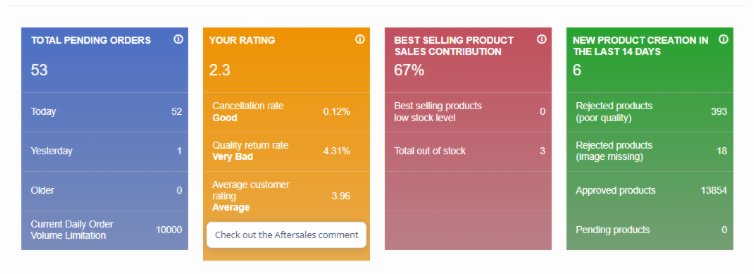
Through the item page, consumers can check the "SELLER INFORMATION" on the right to view the seller score. In the following item pages, the seller score in the Seller Center is assumed to be 2.7 and then divided by the total score (5). The final score displayed is 54% Seller Score (2.7/5=54%), that is, the percentage of the seller's score to the total score is 54%:
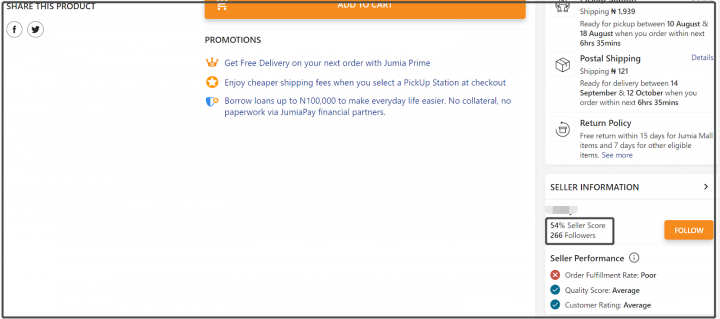
1.3 Composition of Seller Score and Scoring Standards
The seller score consists of the following three indicators, which are updated every Tuesday:
| No. | Key performance | Performance definition | | --- | ----------------------------------------------------------- | ----------------------------------------------------------------------------------- | | 1 | Cancellation Rate (due to sellers' reason, CR for short) | 体现了店铺库存的稳定程度,指过去4周内作为缺货(Out of stock)被取消的产品数量百分比 | | 2 | Quality Return Rate (due to sellers' reason, QRR for short) | 体现了店铺产品的质量水平,指过去4周内经过售后团队核实的有质量问题的产品数量百分比 | | 3 | Average Customer Rating (ACR) | 体现了消费者对使用过的产品或服务的评价,指过去4周内店铺有收到的所有产品评分的平均值 |
Note: "The past 4 weeks" is based on the current week when the seller scores of shops are updated. "Minus 2 weeks to minus 5 weeks" composes a complete calculation period. For example, the seller score shown in the background in the 50th week is the average of the scores rated in the 48th, 47th, 46th, and 45th weeks.
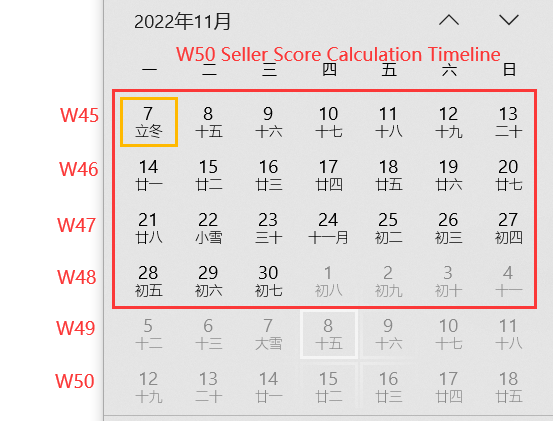
- Only those orders canceled by the seller due to OOS or automatically canceled by the system because the packages are not sent to the warehouse for scanning within the prescribed time limit (5 workdays) are not calculated. The orders that are canceled due to other reasons (canceled by customers, platform system problems, etc.) are not included in the calculation scope.
- A detailed explanation of Out of Stock: Once the order is generated, the seller has 5 workdays for goods preparing, printing shipping labels, warehouse scanning, and other operations. Otherwise, the system cancels the order because the item is out of stock.
- The default seller score is 3.0 within 30 days after the shop is activated. If there are 5 or more finished orders within 30 days, the seller score will be adjusted according to the shop's performance.
Note:
- CR is calculated based on the number of canceled items, not the canceled orders. Besides, CR is calculated according to the date of order generation, and the date corresponds to the calculation period of the Seller Score.
- QRR is calculated based on the number of returned items, not the returned orders. Besides, QRR is calculated according to the date of the order delivered, and the date corresponds to the calculation period of Seller Score.
Calculation examples are as follows:
Calculation example of the 50th week's CR
(The 50th week's CR of the shop is calculated based on the orders generated within the previous four weeks, i.e. 48th, 47th, 46th, and 45th weeks)
| Site | Shop name | Orders (Week 45 - 48 | Total SKUs (Week 45 - 48) | SKUs canceled (Week 45 - 48) | 50th week's CR (Canceled SKUs/Total SKUs) |
| ---- | --------- | -------------------- | --------------------------------------------------------------- | ----------------------------------------------------------------------- | ----------------------------------------- |
| NG | Jumia | 2 | 110
(Order A includes 100 SKUs,Order B includes 10 SKUs) | 100 SKUs of Order A were canceled by the system due to delayed delivery | 100/110=91% |
Calculation example of the 50th week's QRR
(The 50th week's RR of the shop is calculated based on the orders delivered within the previous four weeks, i.e. 48th, 47th, 46th, and 45th weeks)
| Site | Shop name | Orders (Week 45 - 48) | Total SKUs (Week 45 - 48) | SKUs returned (Week 45 - 48) | 50th week's QRR (returned SKUs/Total SKUs) | | ---- | --------- | --------------------- | ---------------------------------------------------------------------------- | ---------------------------------------------------- | ------------------------------------------ | | NG | Jumia | 2 | 60(Order A includes 10 SKUs delivered,Order B includes 50 SKUs delivered) | 10 SKUs of Order A were returned due to poor quality | 10/60=17% |
Scoring standard and weight of seller score:
*Weight:
| Factors for seller score rating | Ratio | | ---------------------------------------------------------------- | ----- | | Cancellation Rate (cancellation rate due to sellers' reason, CR) | 1/3 | | Quality Return Rate (return rate due to sellers' reason, QRR) | 1/3 | | Average Customer Rating (average rating of users,ACR) | 1/3 |
*Scoring standard:
| Score | Range | CR | QRR | ACR (f) | | ----- | --------- | ------- | ------- | --------- | | 5 | Excellent | 0%-0.1% | 0%-0.1% | 4.5≤f≤5 | | 4 | Good | 0.1%-1% | 0.1%-1% | 4≤f<4.5 | | 3 | Average | 1%-2% | 1%-2% | 3≤f<4 | | 2 | Bad | 2%-3% | 2%-3% | 2≤f<3 | | 1 | Very bad | 3%-4% | 3%-4% | 1.5≤f<2 | | 0 | Very bad | 4%-100% | 4%-100% | f<1.5 |
Example
It is assumed that CR, QRR, and ACR of Seller A are as follows:
First, match the corresponding range; then, get the score according to the range; finally, multiply each score by the weight (1/3) and sum them up to get the score.
| Item | Performance | Range | Score |
| -------------------------------------------------------------------------------------------------- | ----------- | -------- | ----- |
| Cancellation Rate (CR) | 2.50% | Bad | 2 |
| Quality Return Rate (QRR) | 3.50% | Very bad | 1 |
| Average Customer Rating (ACR) | 3.5 | Average | 3 |
| The proportion of each item is 1/3, and the final score of the shop is:
2*1/3+1*1/3+3*1/3=2 | | | |
1.4 How Does Seller Score Impact Shops?
- Your seller score will be displayed on the item page. Generally, the item conversion rate of the shops with a high seller score is about 5 to 10 times greater than that of non-high-scoring shops.
- The platform gives more data support to the shops with a high seller score. The higher the score, the more data given.
- For shops with low seller scores (<3 only), in addition to data limitation, the platform will also charge additional commissions at different gradients based on their scores.
The additional commission* is charged as follows (taking Nigeria as an example):
Contribution for low seller score = Commission fee for last week * ratio for low seller score
Example of a seller with 5% commission on Jumia
| Seller Score Min | Seller Score Max | Contribution% | Weekly Sales (Last week) | Commission - Last week (NGN) | Contribution Fee - this week (NGN) | | -------------------------- | -------------------------- | ----------------------- | ---------------------------------- | -------------------------------------- | -------------------------------------------- | | 3 | 5 | 0% | 35,000 NGN | 5%* 35,000 = 1,750 | 0% x 1,750 = 0 | | 2.5 | 3 | 20% | 35,000 NGN | 5%* 35,000 = 1,750 | 20% x 1,750 = 350 | | 2 | 2.5 | 30% | 35,000 NGN | 5%* 35,000 = 1,750 | 30% x 1,750 = 525 | | 1.5 | 2 | 50% | 35,000 NGN | 5%* 35,000 = 1,750 | 50% x 1,750 = 875 | | 0 | 1.5 | 75% | 35,000 NGN | 5%* 35,000 = 1,750 | 75% x 1,750 = 1,312.5 |
The extra commission is shown in the bill as "Contribution for low seller score:
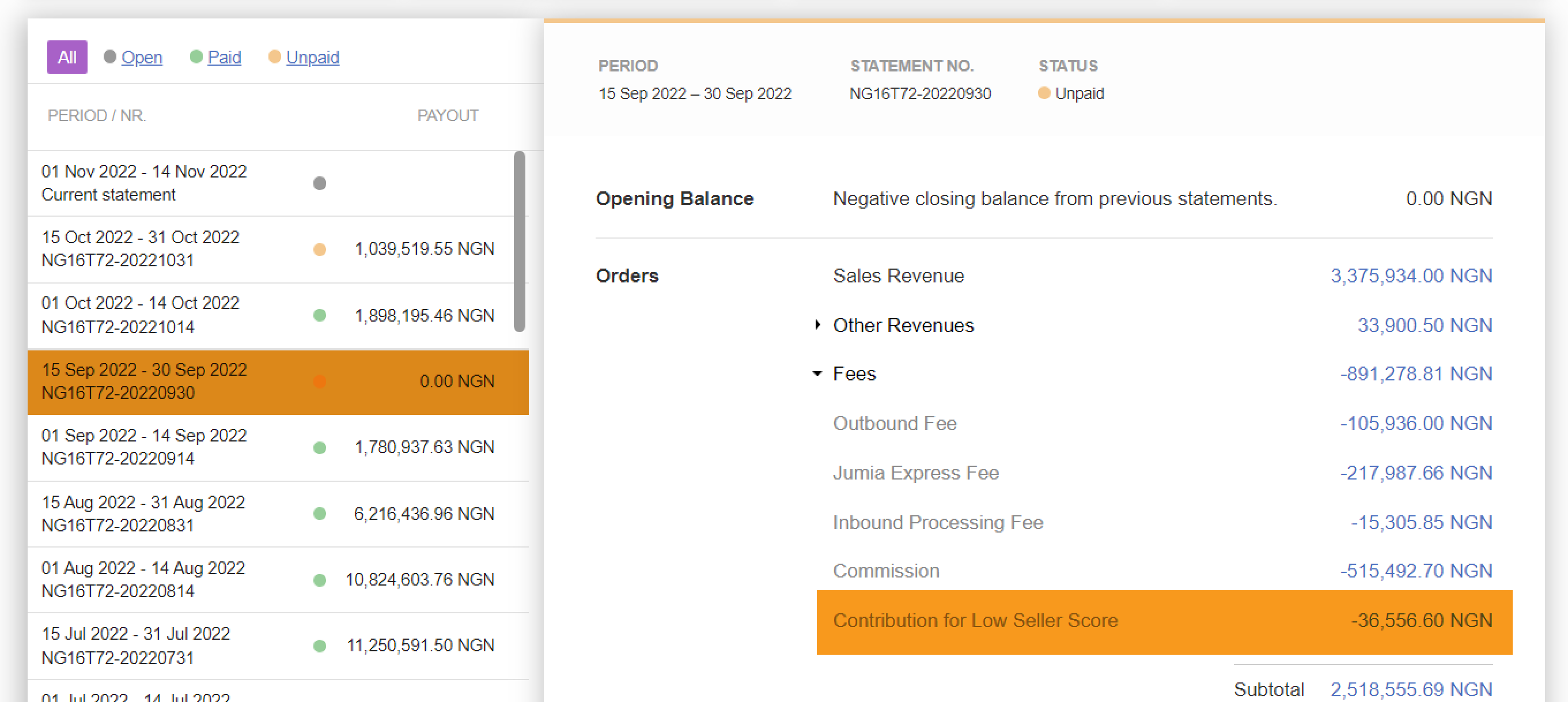
- High CR, high QRR and low ACR lead to the following results:
- Triggering shop delisting (Click here to see how to apply for shop relisting; click here to view relevant policies)
- items are rejected for themed promotion (only quality items are allowed).
- Decreased exposure rate (the seller score and related indicators are visible to buyers, which affects consumers' trust in goods).
1.5 How to Improve the Seller Score?
The seller score is composed of CR, QRR, and ACR. To keep a high seller score, the shop owner shall ensure that each indicator has good performance.
How to avoid CR (cancellation rate due to seller's reason)?
- Short-term solutions
- Increasing order exposure: reduce the impact of OOS by increasing sales volume through discounts, advertising, promotion, etc.
- Avoiding new OOS orders: timely adjust the inventory, and delist the items with 0 inventory.
- A large number of orders are going to expire and not handled: the situation should be timely fed back to the platform through RAC for support.
- Long-term solutions
Well inventory management: keep supply stable/timely update inventory/stock up before major promotion.
- Well delivery management: timely check new orders every day; check the item quality before delivery; reduce the wrong and miss delivery, and avoid QC failure
- Well logistics management: timely track the arrival and scanning of packages; select superior third-party logistics company to avoid missing packages or delayed delivery
- Summary of FAQ
Promptly check new order notifications in the mailbox to timely deal with orders.
- Update the order status to "Ready to ship" before printing the shipping label.
- Select the correct shipping provider before printing the shipping label. Once the wrong one is selected and printed, the order number will be tracked and cannot be revoked, and the order cannot be scanned.
- Get familiar with the delivery process of Dropshipping (DS) packages, including overweight, oversiz,e and split delivery, etc.
- Be clear about SEKO warehouse and postal parcel warehouse to prevent shipping to the wrong warehouse and affecting the receiving time.
- Be familiar with Smart QC rules to avoid order cancellation by the system due to QC failure.
- When encountering abnormal orders, ask for help through RAC in time (e.g. you cannot click "Ready to ship", and you have deleted SKU order, etc.).
How to reduce QRR (return rate due to sellers' reasons)?
- Preventive measures
Make sure the correct items (color, size, etc.) are shipped.
- Ensure that the original items are delivered (e.g.: non-counterfeit).
- Correctly pack the items as per the packing guidance of the platform.
- Describe the item function, content, etc. in detail on the item page to ensure that customers receive the item that matches the description on the website.
- Post-return optimization
Sellers can find "Return" related orders through the following path, and click on orders to view the reasons for the return.
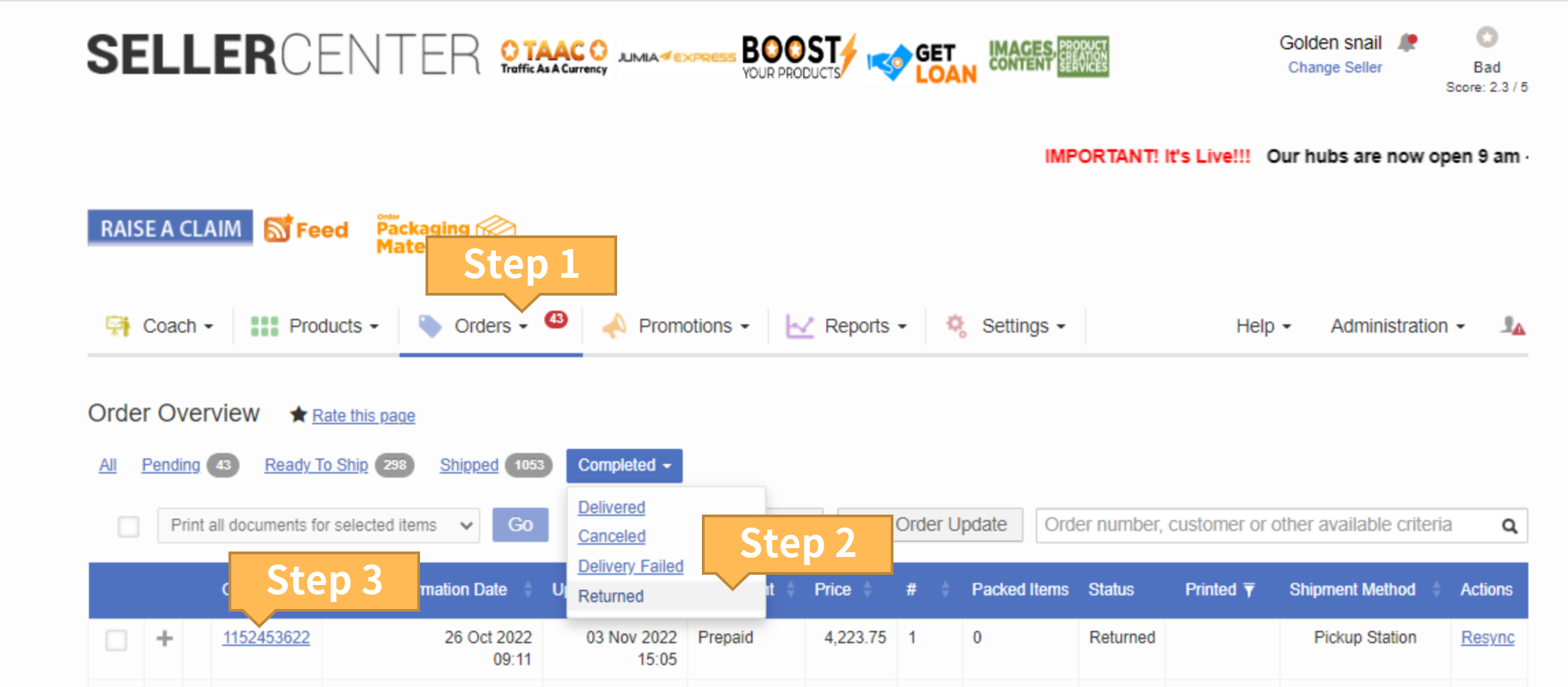
- "Status" shows the return reason; "Comments" gives specific explanations or figures
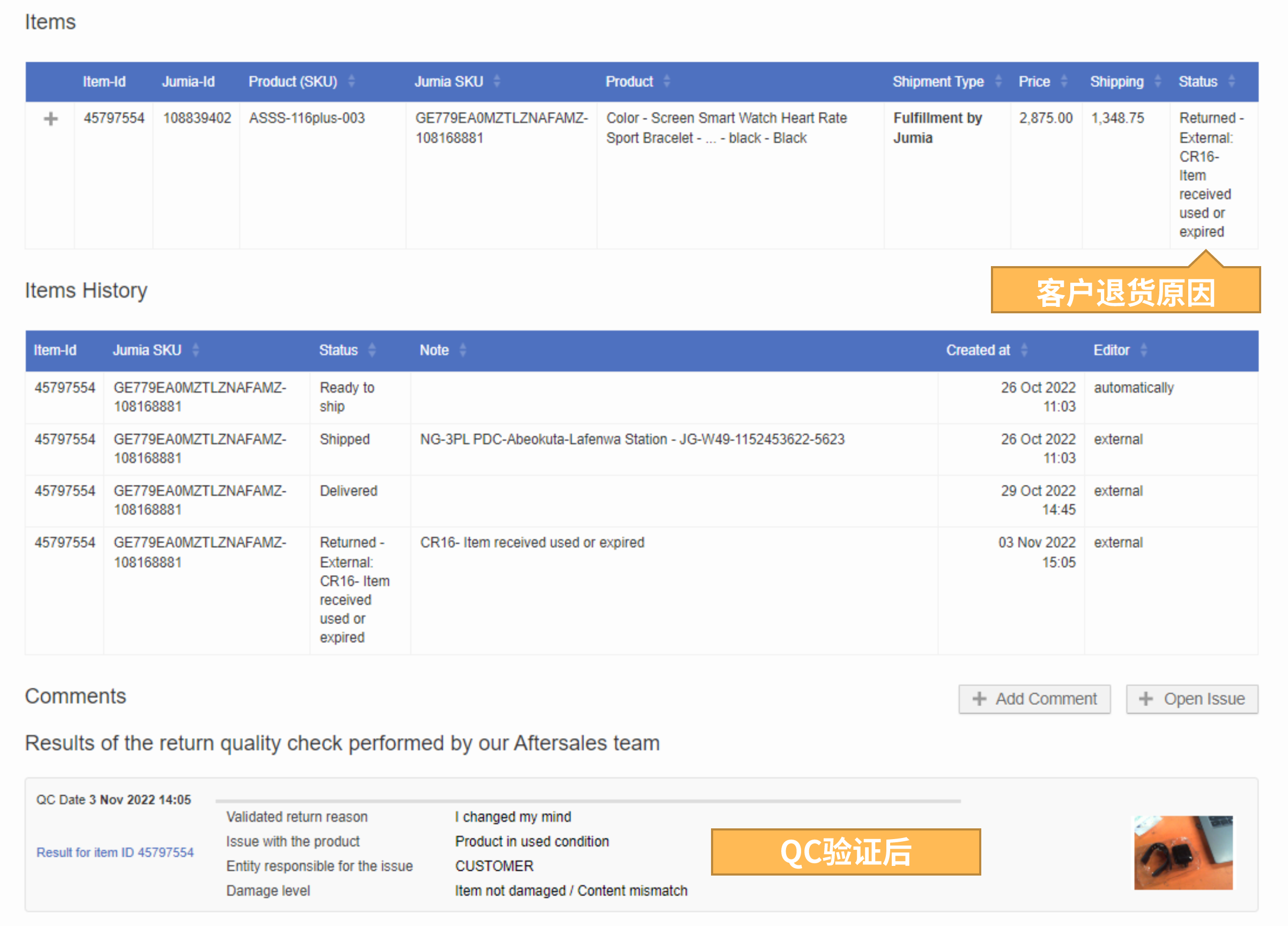
*The following table lists the rank of common reasons for Quality Return. Sellers should focus on the orders with the following return reasons, *and optimize items according to the descriptions of customers or pictures provided by the after-sales team to reduce returns.
| Return Reason | RANK | | ------------------------------------------------------ | ----- | | CR06 - Item stopped working well after usage | Top 1 | | CR12 - Item received broken or defective | Top 2 | | CR24 - Wrong item / color / size / model | Top 3 | | CR15 - Item received with missing parts or accessories | Top 4 | | CR13 - Packaging was damaged | Top 5 |
How to improve ACR (Average Customer Rating)?
Because CR and QRR affect customer experience to various degrees, it is necessary to retain CR and QRR at a low level to reduce negative comments.
Furthermore:
- Do not over-render pictures, so as to prevent the customers from giving negative comments due to color differences and other problems.
- Items should have (simple) operation instructions, so as to avoid customers giving negative comments because they do not know how to use the items.
- The material of the item should match its description on the website, so as to prevent customers from making negative comments because the items received are different from the description on the website.
- The size of fashion items should correspond to the local standard (e.g. Nigeria: UK Size), so as to prevent customers from making negative comments because they don't know how to use them.
- Voltage, plug, and other accessories of an electronic item should comply with the local standard (e.g. Nigeria: UK Size), so as to prevent customers from making negative comments because they cannot use them.
2.Vendor Center Seller Score
2.1 What is Seller Score ?
On the Jumia platform, the seller score refers to the comprehensive operation performance of the shop, including cancellation rate (CR), quality return rate (QRR), and item score of the shop in the past period. The higher the score, the higher the consumer's trust in the shop.
Good seller scores are mainly used in the following three aspects:
- Helping consumers find reliable shops;
- Helping sellers monitor the health of shops, discover problems, and optimize shops in time;
- Attracting more consumers and increasing sales.
2.2 How to Check My Seller Score?
Sellers can log in to the main page of the Seller Center and check "YOUR RATING" to view the seller score.
Click the "Country" drop-down box on the right hand side to filter the corresponding country.
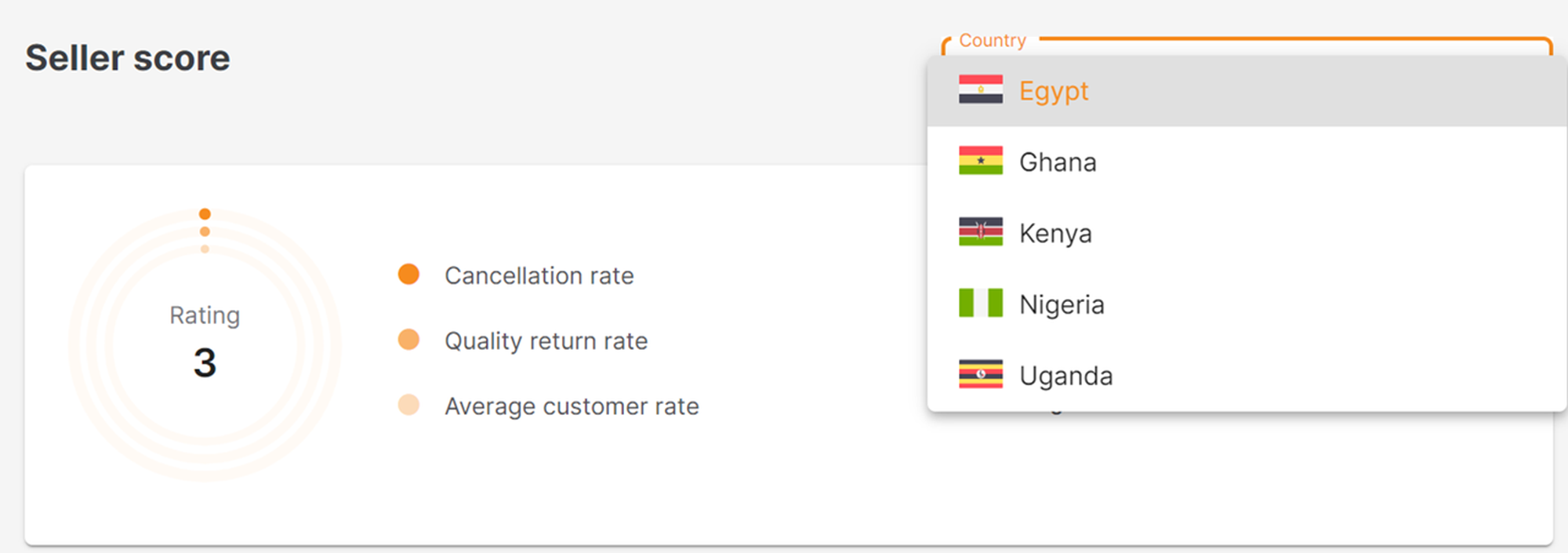
Through the item page, consumers can check the "SELLER INFORMATION" on the right to view the seller score. In the following item pages, the seller score in the Seller Center is assumed to be 2.7 and then divided by the total score (5). The final score displayed is 54% Seller Score (2.7/5=54%), that is, the percentage of the seller's score to the total score is 54%:
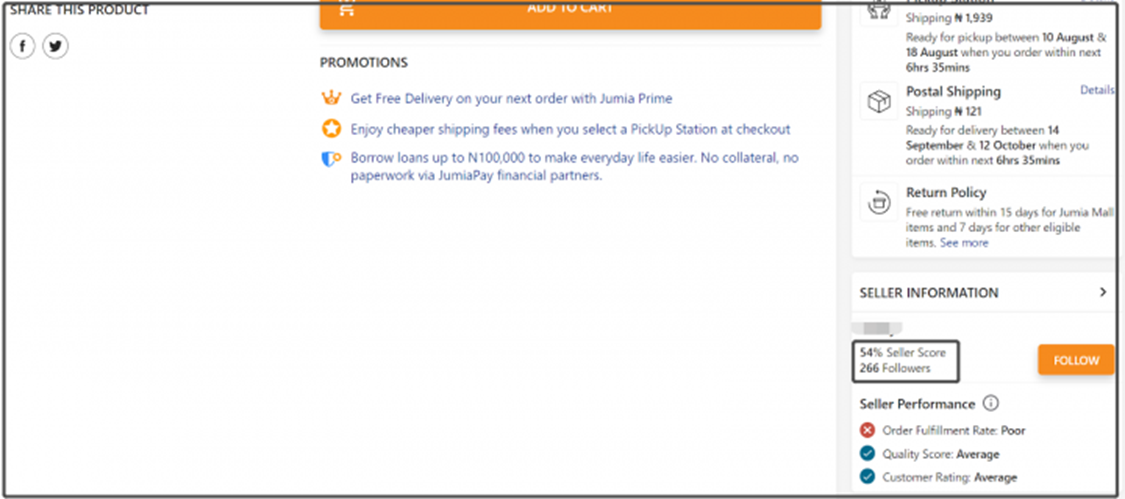
2.3 Composition of Seller Score and Scoring Standards
The seller score consists of the following three indicators, which are updated every Tuesday:
| 序 | 关键指标 | Performance definition | | -- | --------------------------------------------------- | -------------------------------------------------------------------------------------------------------------------------------------------- | | 1 | Cancellation Rate (卖家原因产生的取消率,简称CR) | stability of store inventory, refers to the % of products that canceled as Out of stock in the past 4 weeks | | 2 | Quality Return Rate (卖家原因产生的退货率,简称QRR) | quality level of the products,% of products with quality problems verified by the after-sales team in the past 4 weeks | | 3 | Average Customer Rating (用户平均评分,简称ACR) | consumer's evaluation of the used product or service, refers to the average of all product ratings received by the store in the past 4 weeks |
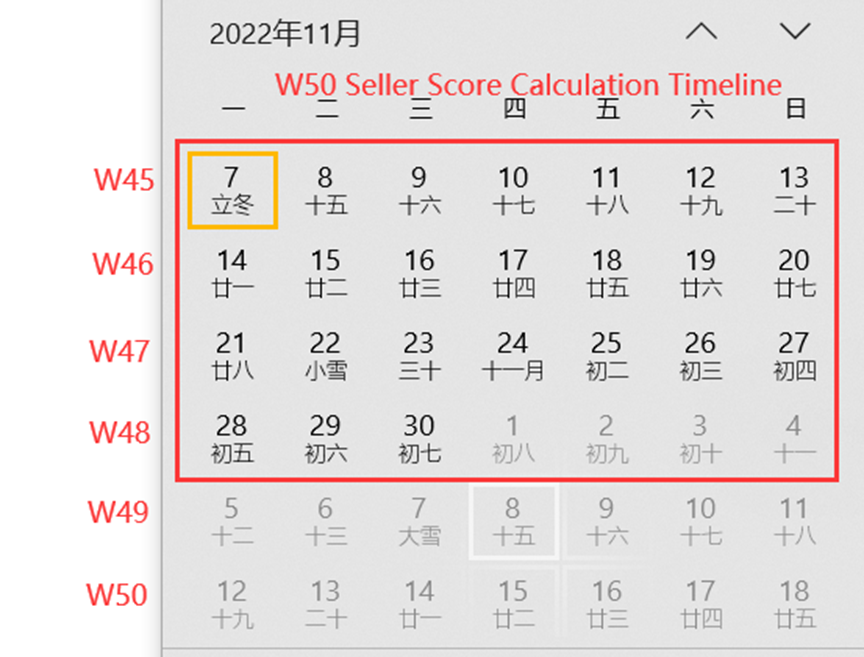
- A detailed explanation of Out of Stock: Once the order is generated, the seller has 5 workdays for goods preparation, printing shipping labels, warehouse scanning, and other operations. Otherwise, the system cancels the order because the item is out of stock.
- Only those orders canceled by the seller due to OOS or automatically canceled by the system because the packages are not sent to the warehouse for scanning within the prescribed time limit (5 workdays) are calculated. The orders that are canceled due to other reasons (canceled by customers, platform system problems, etc.) are not included in the calculation scope.
- The default seller score is 3.0 within 30 days after the shop is activated. If there are 5 or more finished orders within 30 days, the seller score will be adjusted according to the shop's performance.
Note:
- CR is calculated based on the number of canceled items, not the canceled orders. Besides, CR is calculated according to the date of order generation, and the date corresponds to the calculation period of the Seller Score.
- QRR is calculated based on the number of returned items, not the returned orders. Besides, QRR is calculated according to the date of the order delivered, and the date corresponds to the calculation period of Seller Score.
- Calculation example of the 50th week's CR
(The 50th week's CR of the shop is calculated based on the orders generated within the previous four weeks, i.e. 48th, 47th, 46th, and 45th weeks)
| Site | Shop name | Orders (Week 45 - 48 | Total SKUs (Week 45 - 48) | SKUs canceled (Week 45 - 48) | 50th week's CR (Canceled SKUs/Total SKUs) | | ---- | --------- | -------------------- | ---------------------------------------------------------- | ----------------------------------------------------------------------- | ----------------------------------------- | | NG | Jumia | 2 | 110(Order A includes 100 SKUs,Order B includes 10 SKUs) | 100 SKUs of Order A were canceled by the system due to delayed delivery | 100/110=91% |
- Calculation example of the 50th week's QRR
(The 50th week's RR of the shop is calculated based on the orders delivered within the previous four weeks, i.e. 48th, 47th, 46th, and 45th weeks)
| Site | Shop name | Orders (Week 45 - 48) | Total SKUs (Week 45 - 48) | SKUs returned (Week 45 - 48) | 50th week's QRR (returned SKUs/Total SKUs) | | ---- | --------- | --------------------- | ---------------------------------------------------------------------------- | ---------------------------------------------------- | ------------------------------------------ | | NG | Jumia | 2 | 60(Order A includes 10 SKUs delivered,Order B includes 50 SKUs delivered) | 10 SKUs of Order A were returned due to poor quality | 10/60=17% |
- Weight of seller score: | Factors for seller score rating | Ratio | | ---------------------------------------------------------------- | ----- | | Cancellation Rate (cancellation rate due to sellers' reason, CR) | 1/3 | | Quality Return Rate (return rate due to sellers' reason, QRR) | 1/3 | | Average Customer Rating (average rating of users,ACR) | 1/3 |
- Scoring standard: | Score | Range | CR | QRR | ACR (f) | | ----- | --------- | ------- | ------- | --------- | | 5 | Excellent | 0%-0.1% | 0%-0.1% | 4.5≤f≤5 | | 4 | Good | 0.1%-1% | 0.1%-1% | 4≤f<4.5 | | 3 | Average | 1%-2% | 1%-2% | 3≤f<4 | | 2 | Bad | 2%-3% | 2%-3% | 2≤f<3 | | 1 | Very bad | 3%-4% | 3%-4% | 1.5≤f<2 | | 0 | Very bad | 4%-100% | 4%-100% | f<1.5 |
Example
It is assumed that CR, QRR, and ACR of Seller A are as follows:
First, match the corresponding range; then, get the score according to the range; finally, multiply each score by the weight (1/3) and sum them up to get the score.
| Item | Performance | Range | Score | | ----------------------------------------------------------------------------------------------- | ----------- | -------- | ----- | | Cancellation Rate (CR) | 2.50% | Bad | 2 | | Quality Return Rate (QRR) | 3.50% | Very bad | 1 | | Average Customer Rating (ACR) | 3.5 | Average | 3 | | The proportion of each item is 1/3, and the final score of the shop is: 2*1/3+1*1/3+3*1/3=2 | | | |
Seller score
As the most important indicator to measure the health of the shop, sellers need to know the scoring standard of the seller score and how to improve it.
1. Seller Center Seller Score
1) What is Seller Score ?
On the Jumia platform, the seller score refers to the comprehensive operation performance of the shop, including cancellation rate (CR), quality return rate (QRR), and item score of the shop in the past period. The higher the score, the higher the consumer's trust in the shop.
Good seller scores are mainly used in the following three aspects:
- Helping consumers find reliable shops;
- Helping sellers monitor the health of shops, discover problems, and optimize shops in time;
- Attracting more consumers and increasing sales.
2) How to Check My Seller Score?
Sellers can log in to the main page of the Seller Center and check "YOUR RATING" to view the seller score.


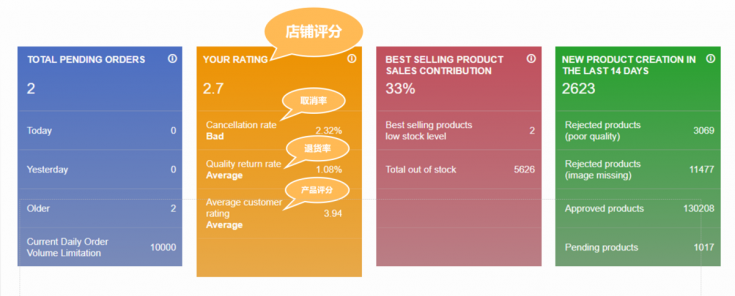

Through the item page, consumers can check the "SELLER INFORMATION" on the right to view the seller score. In the following item pages, the seller score in the Seller Center is assumed to be 2.7 and then divided by the total score (5). The final score displayed is 54% Seller Score (2.7/5=54%), that is, the percentage of the seller's score to the total score is 54%:

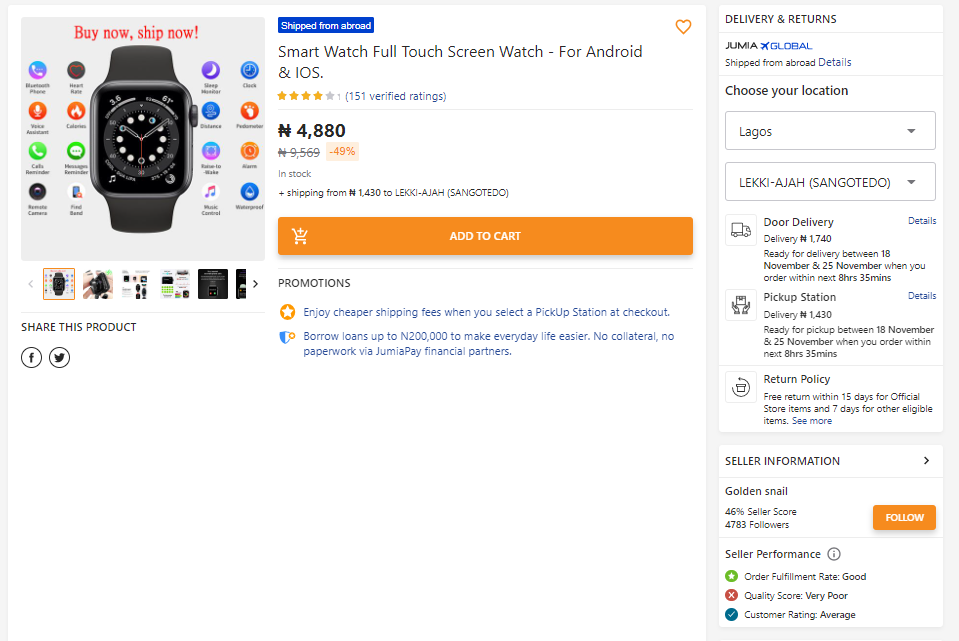
3) Composition of Seller Score and Scoring Standards
The seller score consists of the following three indicators, which are updated every Tuesday:
| No. | Key performance | Performance definition | | --- | ----------------------------------------------------------- | -------------------------------------------------------------------------------------------------------------------------------------------- | | 1 | Cancellation Rate (due to sellers' reason, CR for short) | stability of store inventory, refers to the % of products that canceled as Out of stock in the past 4 weeks | | 2 | Quality Return Rate (due to sellers' reason, QRR for short) | quality level of the products,% of products with quality problems verified by the after-sales team in the past 4 weeks | | 3 | Average Customer Rating (ACR) | consumer's evaluation of the used product or service, refers to the average of all product ratings received by the store in the past 4 weeks |
Note: "The past 4 weeks" is based on the current week when the seller scores of shops are updated. "Minus 2 weeks to minus 6 weeks" composes a complete calculation period. For example, the seller score shown in the background in the *50th week is the average* of the scores rated in the 48th, 47th, 46th, and 4**5th weeks.
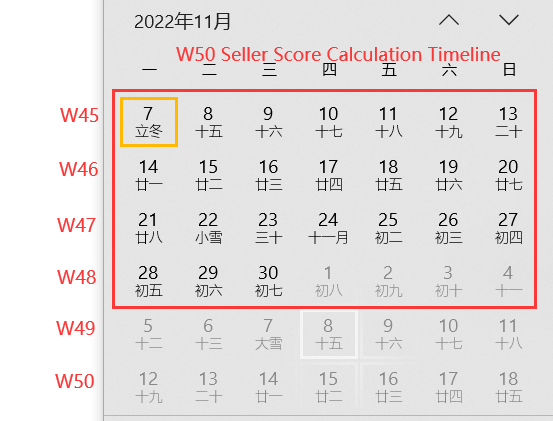
- Only those orders canceled by the seller due to OOS or automatically canceled by the system because the packages are not sent to the warehouse for scanning within the prescribed time limit (5 workdays) are not calculated. The orders that are canceled due to other reasons (canceled by customers, platform system problems, etc.) are not included in the calculation scope.
- A detailed explanation of Out of Stock: Once the order is generated, the seller has 5 workdays for goods preparing, printing shipping labels, warehouse scanning, and other operations. Otherwise, the system cancels the order because the item is out of stock.
- The default seller score is 3.0 within 30 days after the shop is activated. If there are 5 or more finished orders within 30 days, the seller score will be adjusted according to the shop's performance.
Note:
- CR is calculated based on the number of canceled items, not the canceled orders. Besides, CR is calculated according to the date of order generation, and the date corresponds to the calculation period of the Seller Score.
- QRR is calculated based on the number of returned items, not the returned orders. Besides, QRR is calculated according to the date of the order delivered, and the date corresponds to the calculation period of Seller Score.
Calculation examples are as follows:
Calculation example of the 50****th week's CR
(The 50th week's CR of the shop is calculated based on the orders generated within the previous four weeks, i.e. 48th, 47th, 46th, and 45th weeks)
| Site | Shop name | Orders (Week 45 - 48 | Total SKUs (Week 45 - 48) | SKUs canceled (Week 45 - 48) | 50th week's CR (Canceled SKUs/Total SKUs) |
| ---- | --------- | -------------------- | --------------------------------------------------------------- | ----------------------------------------------------------------------- | ----------------------------------------- |
| NG | Jumia | 2 | 110
(Order A includes 100 SKUs,Order B includes 10 SKUs) | 100 SKUs of Order A were canceled by the system due to delayed delivery | 100/110=91% |
Calculation example of the 50th week's QRR
(The 50th week's RR of the shop is calculated based on the orders delivered within the previous four weeks, i.e. 48th, 47th, 46th, and 45th weeks)
| Site | Shop name | Orders (Week 45 - 48) | Total SKUs (Week 45 - 48) | SKUs returned (Week 45 - 48) | 50th week's QRR (returned SKUs/Total SKUs) | | ---- | --------- | --------------------- | ---------------------------------------------------------------------------- | ---------------------------------------------------- | ------------------------------------------ | | NG | Jumia | 2 | 60(Order A includes 10 SKUs delivered,Order B includes 50 SKUs delivered) | 10 SKUs of Order A were returned due to poor quality | 10/60=17% |
Scoring standard and weight of seller score:
*Weight:
| Factors for seller score rating | Ratio | | ---------------------------------------------------------------- | ----- | | Cancellation Rate (cancellation rate due to sellers' reason, CR) | 1/3 | | Quality Return Rate (return rate due to sellers' reason, QRR) | 1/3 | | Average Customer Rating (average rating of users,ACR) | 1/3 |
*Scoring standard:
| Score | Range | CR | QRR | ACR (f) | | ----- | --------- | ------- | ------- | --------- | | 5 | Excellent | 0%-0.1% | 0%-0.1% | 4.5≤f≤5 | | 4 | Good | 0.1%-1% | 0.1%-1% | 4≤f<4.5 | | 3 | Average | 1%-2% | 1%-2% | 3≤f<4 | | 2 | Bad | 2%-3% | 2%-3% | 2≤f<3 | | 1 | Very bad | 3%-4% | 3%-4% | 1.5≤f<2 | | 0 | Very bad | 4%-100% | 4%-100% | f<1.5 |
Example
It is assumed that CR, QRR, and ACR of Seller A are as follows:
First, match the corresponding range; then, get the score according to the range; finally, multiply each score by the weight (1/3) and sum them up to get the score.
| Item | Performance | Range | Score |
| -------------------------------------------------------------------------------------------------- | ----------- | -------- | ----- |
| Cancellation Rate (CR) | 2.50% | Bad | 2 |
| Quality Return Rate (QRR) | 3.50% | Very bad | 1 |
| Average Customer Rating (ACR) | 3.5 | Average | 3 |
| The proportion of each item is 1/3, and the final score of the shop is:
2*1/3+1*1/3+3*1/3=2 | | | |
4) How Does the Seller Score Impact Shops?
- Your seller score will be displayed on the item page. Generally, the item conversion rate of the shops with a high seller score is about 5 to 10 times greater than that of non-high-scoring shops.
- The platform gives more data support to the shops with a high seller score. The higher the score, the more data is given.
- For shops with low seller scores (<3 only), in addition to data limitation, the platform will also charge additional commissions at different gradients based on their scores.
The additional commission* is charged as follows (taking Nigeria as an example):
Contribution for low seller score = Commission fee for last week * ratio for low seller score
| Example of a seller with 5% commission on Jumia | | ----------------------------------------------- | | Seller Score Min | | 3 | | 2.5 | | 2 | | 1.5 | | 0 |
The extra commission is shown in the bill as "Contribution for low seller score:

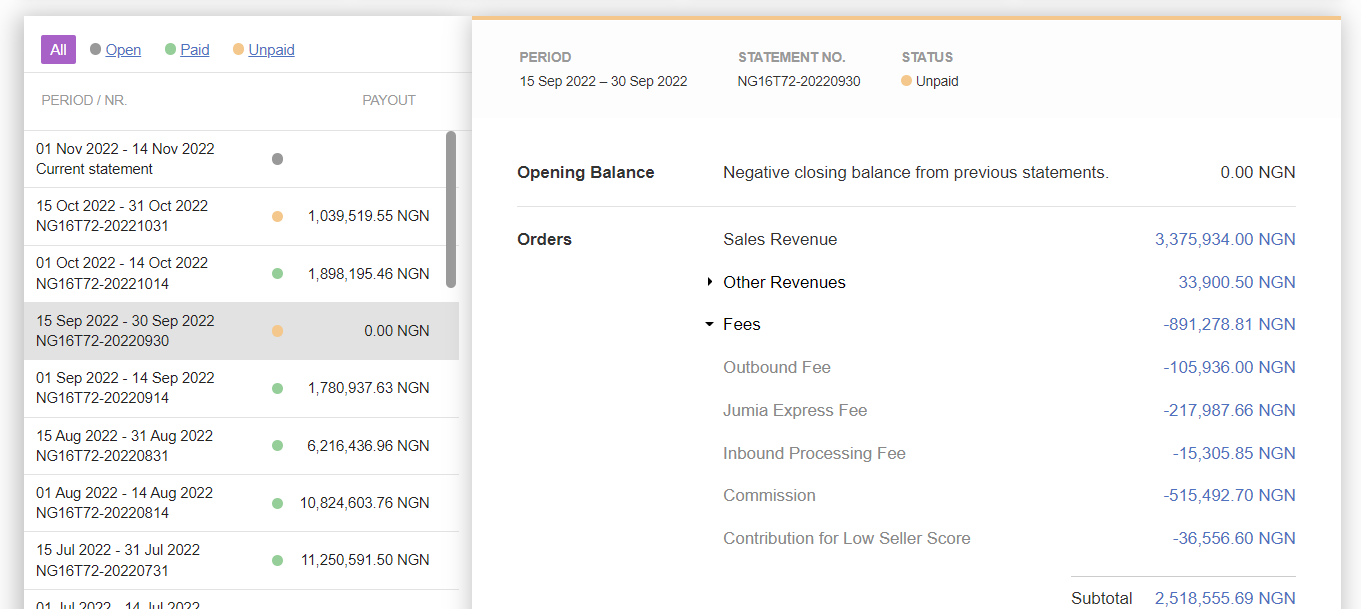
- High CR, high QRR and low ACR lead to the following results:
- Triggering shop delisting (Click here to see how to apply for shop relisting; click here to view relevant policies)
- items are rejected for themed promotion (only quality items are allowed).
- Decreased exposure rate (the seller score and related indicators are visible to buyers, which affects consumers' trust in goods).
5) How to Improve the Seller Score?
The seller score is composed of CR, QRR, and ACR. To keep a high seller score, the shop owner shall ensure that each indicator has good performance.
How to avoid CR (cancellation rate due to seller's reason)?
- Short-term solutions
- Increasing order exposure: reduce the impact of OOS by increasing sales volume through discounts, advertising, promotion, etc.
- Avoiding new OOS orders: timely adjust the inventory, and delist the items with 0 inventory.
- A large number of orders are going to expire and not handled: the situation should be timely fed back to the platform through RAC for support.
- Long-term solutions
Well inventory management: keep supply stable/timely update inventory/stock up before major promotion.
- Well delivery management: timely check new orders every day; check the item quality before delivery; reduce the wrong and miss delivery, and avoid QC failure
- Well logistics management: timely track the arrival and scanning of packages; select superior third-party logistics company to avoid missing packages or delayed delivery
- Summary of FAQ
Promptly check new order notifications in the mailbox to timely deal with orders.
- Update the order status to "Ready to ship" before printing the shipping label.
- Select the correct shipping provider before printing the shipping label. Once the wrong one is selected and printed, the order number will be tracked and cannot be revoked, and the order cannot be scanned.
- Get familiar with the delivery process of Dropshipping (DS) packages, including overweight, oversiz,e and split delivery, etc.
- Be clear about SEKO warehouse and postal parcel warehouse to prevent shipping to the wrong warehouse and affecting the receiving time.
- Be familiar with Smart QC rules to avoid order cancellation by the system due to QC failure.
- When encountering abnormal orders, ask for help through RAC in time (e.g. you cannot click "Ready to ship", and you have deleted SKU order, etc.).
How to reduce QRR (return rate due to sellers' reasons)?
- Preventive measures
Make sure the correct items (color, size, etc.) are shipped.
- Ensure that the original items are delivered (e.g.: non-counterfeit).
- Correctly pack the items as per the packing guidance of the platform.
- Describe the item function, content, etc. in detail on the item page to ensure that customers receive the item that matches the description on the website.
- Post-return optimization
Sellers can find "Return" related orders through the following path, and click on orders to view the reasons for the return.
- "Status" shows the return reason; "Comments" gives specific explanations or figures
The following table lists the rank of common reasons for Quality Return. Sellers should focus on the orders with the following return reasons, and optimize items according to the descriptions of customers or pictures provided by the after-sales team to reduce returns.
| Return Reason | RANK | | ------------------------------------------------------ | ----- | | CR06 - Item stopped working well after usage | Top 1 | | CR12 - Item received broken or defective | Top 2 | | CR24 - Wrong item / color / size / model | Top 3 | | CR15 - Item received with missing parts or accessories | Top 4 | | CR13 - Packaging was damaged | Top 5 |
How to improve ACR (Average Customer Rating)?
Because CR and QRR affect customer experience to various degrees, it is necessary to retain CR and QRR at a low level to reduce negative comments.
Furthermore:
- Do not over-render pictures, so as to prevent the customers from giving negative comments due to color differences and other problems.
- Items should have (simple) operation instructions, so as to avoid customers giving negative comments because they do not know how to use the items.
- The material of the item should match its description on the website, so as to prevent customers from making negative comments because the items received are different from the description on the website.
- The size of fashion items should correspond to the local standard (e.g. Nigeria: UK Size), so as to prevent customers from making negative comments because they don't know how to use them.
- Voltage, plug, and other accessories of an electronic item should comply with the local standard (e.g. Nigeria: UK Size), so as to prevent customers from making negative comments because they cannot use them.
2. Vendor Center Seller Score
1) What is Seller Score ?
On the Jumia platform, the seller score refers to the comprehensive operation performance of the shop, including cancellation rate (CR), quality return rate (QRR), and item score of the shop in the past period. The higher the score, the higher the consumer's trust in the shop.
Good seller scores are mainly used in the following three aspects:
- Helping consumers find reliable shops;
- Helping sellers monitor the health of shops, discover problems, and optimize shops in time;
- Attracting more consumers and increasing sales.
2) How to Check My Seller Score?
Sellers can log in to the main page of the Seller Center and check "YOUR RATING" to view the seller score.
Click the "Country" drop-down box on the right hand side to filter the corresponding country.
Through the item page, consumers can check the "SELLER INFORMATION" on the right to view the seller score. In the following item pages, the seller score in the Seller Center is assumed to be 2.7 and then divided by the total score (5). The final score displayed is 54% Seller Score (2.7/5=54%), that is, the percentage of the seller's score to the total score is 54%:
3) Composition of Seller Score and Scoring Standards
The seller score consists of the following three indicators, which are updated every Tuesday:
| 序 | 关键指标 | Performance definition | | -- | --------------------------------------------------- | -------------------------------------------------------------------------------------------------------------------------------------------- | | 1 | Cancellation Rate (卖家原因产生的取消率,简称CR) | stability of store inventory, refers to the % of products that canceled as Out of stock in the past 4 weeks | | 2 | Quality Return Rate (卖家原因产生的退货率,简称QRR) | quality level of the products,% of products with quality problems verified by the after-sales team in the past 4 weeks | | 3 | Average Customer Rating (用户平均评分,简称ACR) | consumer's evaluation of the used product or service, refers to the average of all product ratings received by the store in the past 4 weeks |
- A detailed explanation of Out of Stock: Once the order is generated, the seller has 5 workdays for goods preparation, printing shipping labels, warehouse scanning, and other operations. Otherwise, the system cancels the order because the item is out of stock.
- Only those orders canceled by the seller due to OOS or automatically canceled by the system because the packages are not sent to the warehouse for scanning within the prescribed time limit (5 workdays) are calculated. The orders that are canceled due to other reasons (canceled by customers, platform system problems, etc.) are not included in the calculation scope.
- The default seller score is 3.0 within 30 days after the shop is activated. If there are 5 or more finished orders within 30 days, the seller score will be adjusted according to the shop's performance.
Note:
- CR is calculated based on the number of canceled items, not the canceled orders. Besides, CR is calculated according to the date of order generation, and the date corresponds to the calculation period of the Seller Score.
- QRR is calculated based on the number of returned items, not the returned orders. Besides, QRR is calculated according to the date of the order delivered, and the date corresponds to the calculation period of Seller Score.
- Calculation example of the 50th week's CR
(The 50th week's CR of the shop is calculated based on the orders generated within the previous four weeks, i.e. 48th, 47th, 46th, and 45th weeks)
| Site | Shop name | Orders (Week 45 - 48 | Total SKUs (Week 45 - 48) | SKUs canceled (Week 45 - 48) | 50th week's CR (Canceled SKUs/Total SKUs) |
| ---- | --------- | -------------------- | --------------------------------------------------------------- | ----------------------------------------------------------------------- | ----------------------------------------- |
| NG | Jumia | 2 | 110
(Order A includes 100 SKUs,Order B includes 10 SKUs) | 100 SKUs of Order A were canceled by the system due to delayed delivery | 100/110=91% |
- Calculation example of the 50th week's QRR
(The 50th week's RR of the shop is calculated based on the orders delivered within the previous four weeks, i.e. 48th, 47th, 46th, and 45th weeks)
| Site | Shop name | Orders (Week 45 - 48) | Total SKUs (Week 45 - 48) | SKUs returned (Week 45 - 48) | 50th week's QRR (returned SKUs/Total SKUs) | | ---- | --------- | --------------------- | ---------------------------------------------------------------------------- | ---------------------------------------------------- | ------------------------------------------ | | NG | Jumia | 2 | 60(Order A includes 10 SKUs delivered,Order B includes 50 SKUs delivered) | 10 SKUs of Order A were returned due to poor quality | 10/60=17% |
- Weight of seller score: | Factors for seller score rating | Ratio | | ---------------------------------------------------------------- | ----- | | Cancellation Rate (cancellation rate due to sellers' reason, CR) | 1/3 | | Quality Return Rate (return rate due to sellers' reason, QRR) | 1/3 | | Average Customer Rating (average rating of users,ACR) | 1/3 |
- Scoring standard: | Score | Range | CR | QRR | ACR (f) | | ----- | --------- | ------- | ------- | --------- | | 5 | Excellent | 0%-0.1% | 0%-0.1% | 4.5≤f≤5 | | 4 | Good | 0.1%-1% | 0.1%-1% | 4≤f<4.5 | | 3 | Average | 1%-2% | 1%-2% | 3≤f<4 | | 2 | Bad | 2%-3% | 2%-3% | 2≤f<3 | | 1 | Very bad | 3%-4% | 3%-4% | 1.5≤f<2 | | 0 | Very bad | 4%-100% | 4%-100% | f<1.5 |
Example
It is assumed that CR, QRR, and ACR of Seller A are as follows:
First, match the corresponding range; then, get the score according to the range; finally, multiply each score by the weight (1/3) and sum them up to get the score.
| Item | Performance | Range | Score |
| -------------------------------------------------------------------------------------------------- | ----------- | -------- | ----- |
| Cancellation Rate (CR) | 2.50% | Bad | 2 |
| Quality Return Rate (QRR) | 3.50% | Very bad | 1 |
| Average Customer Rating (ACR) | 3.5 | Average | 3 |
| The proportion of each item is 1/3, and the final score of the shop is:
2*1/3+1*1/3+3*1/3=2 | | | |
4) How Does the Seller Score Impact Shops?
- Your seller score will be displayed on the item page. Generally, the item conversion rate of the shops with a high seller score is about 5 to 10 times greater than that of non-high-scoring shops.
- The platform gives more data support to the shops with a high seller score. The higher the score, the more data is given.
- For shops with low seller scores (<3 only), in addition to data limitation, the platform will also charge additional commissions at different gradients based on their scores.
- The additional commission* is charged as follows (taking Nigeria as an example):
- Contribution for low seller score = Commission fee for last week * ratio for low seller score
- Example of a seller with 5% commission on Jumia
| Seller Score Min | Seller Score Max | Contribution% | Weekly Sales (Last week) | Commission - Last week (NGN) | Contribution Fee - this week (NGN) | | ---------------- | ---------------- | ------------- | ------------------------ | ---------------------------- | ---------------------------------- | | 3 | 5 | 0% | 35,000 NGN | 5%* 35,000 = 1,750 | 0% x 1,750 = 0 | | 2.5 | 3 | 20% | 35,000 NGN | 5%* 35,000 = 1,750 | 20% x 1,750 = 350 | | 2 | 2.5 | 30% | 35,000 NGN | 5%* 35,000 = 1,750 | 30% x 1,750 = 525 | | 1.5 | 2 | 50% | 35,000 NGN | 5%* 35,000 = 1,750 | 50% x 1,750 = 875 | | 0 | 1.5 | 75% | 35,000 NGN | 5%* 35,000 = 1,750 | 75% x 1,750 = 1,312.5 |
-
The extra commission is shown in the bill as "Contribution for low seller score“:

- High CR, high QRR and low ACR lead to the following results:
- Triggering shop delisting (Click here to see how to apply for shop relisting; click here to view relevant policies)
- items are rejected for themed promotion (only quality items are allowed).
- Decreased exposure rate (the seller score and related indicators are visible to buyers, which affects consumers' trust in goods).
5) How to Improve the Seller Score?
The seller score is composed of CR, QRR, and ACR. To keep a high seller score, the shop owner shall ensure that each indicator has good performance.
How to avoid CR (cancellation rate due to seller's reason)?
- Short-term solutions
- Increasing order exposure: reduce the impact of OOS by increasing sales volume through discounts, advertising, promotion, etc.
- Avoiding new OOS orders: timely adjust the inventory, and delist the items with 0 inventory.
- A large number of orders are going to expire and not handled: the situation should be timely fed back to the platform through RAC for support.
- Long-term solutions
Well inventory management: keep supply stable/timely updated inventory/stock up before major promotion.
- Well delivery management: timely check new orders every day; check the item quality before delivery; reduce the wrong and miss delivery, and avoid QC failure
- Well logistics management: timely track the arrival and scanning of packages; select superior third-party logistics company to avoid missing packages or delayed delivery
- Summary of FAQ
Promptly check new order notifications in the mailbox to timely deal with orders.
- Update the order status to "Ready to ship" before printing the shipping label.
- Select the correct shipping provider before printing the shipping label. Once the wrong one is selected and printed, the order number will be tracked and cannot be revoked, and the order cannot be scanned.
- Get familiar with the delivery process of Dropshipping (DS) packages, including overweight, oversiz,e and split delivery, etc.
- Be clear about SEKO warehouse and postal parcel warehouse to prevent shipping to the wrong warehouse and affecting the receiving time.
- Be familiar with Smart QC rules to avoid order cancellation by the system due to QC failure.
- When encountering abnormal orders, ask for help through RAC in time (e.g. you cannot click "Ready to ship", and you have deleted SKU order, etc.).
How to reduce QRR (return rate due to sellers' reasons)?
- Preventive measures
- Make sure the correct items (color, size, etc.) are shipped.
- Ensure that the original items are delivered (e.g.: non-counterfeit).
- Correctly pack the items as per the packing guidance of the platform.
- Describe the item function, content, etc. in detail on the item page to ensure that customers receive the item that matches the description on the website.
- Post-return optimization
Sellers can find "Return" related orders through the following path, and click on orders to view the reasons for the return.
Order > Returned > Click "Order number" > Go to "Order items" details > Expend Order Items
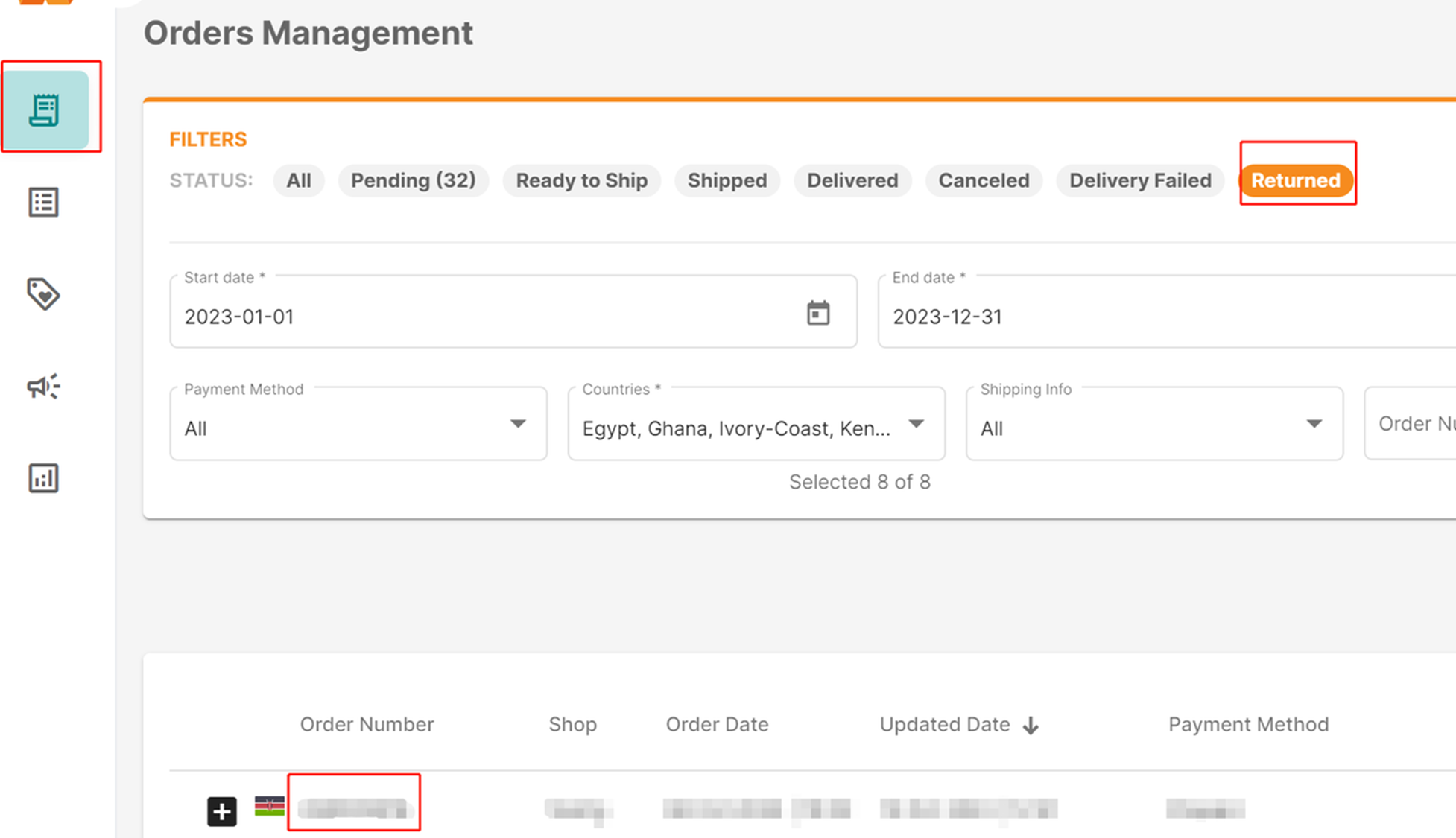
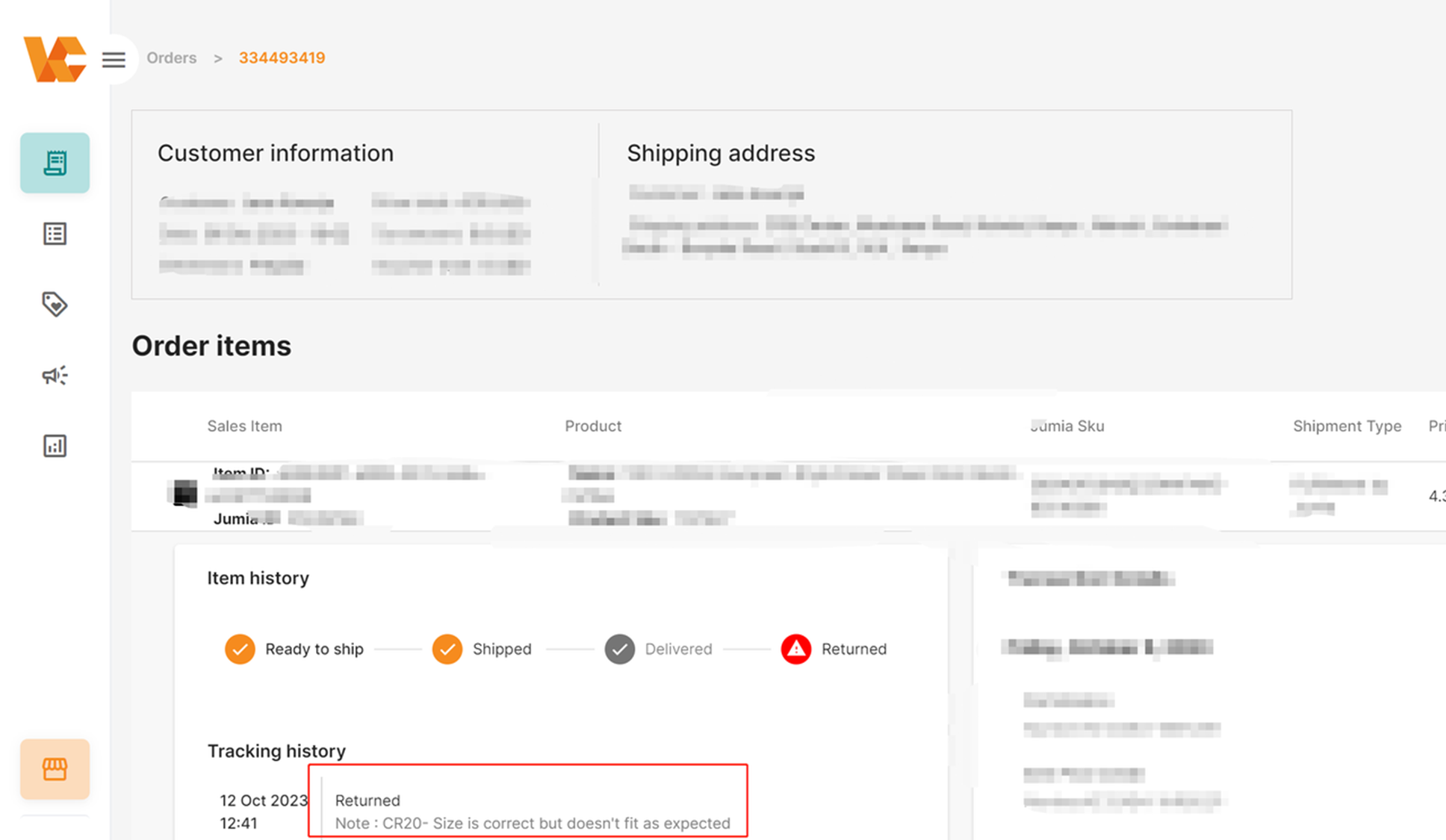
How to improve ACR (Average Customer Rating)?
Because CR and QRR affect customer experience to various degrees, it is necessary to retain CR and QRR at a low level to reduce negative comments.
Furthermore:
- Do not over-render pictures, so as to prevent the customers from giving negative comments due to color differences and other problems.
- Items should have (simple) operation instructions, so as to avoid customers giving negative comments because they do not know how to use the items.
- The material of the item should match its description on the website, so as to prevent customers from making negative comments because the items received are different from the description on the website.
- The size of fashion items should correspond to the local standard (e.g. Nigeria: UK Size), so as to prevent customers from making negative comments because they don't know how to use them.
- Voltage, plug, and other accessories of an electronic item should comply with the local standard (e.g. Nigeria: UK Size), so as to prevent customers from making negative comments because they cannot use them.